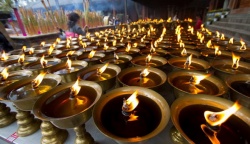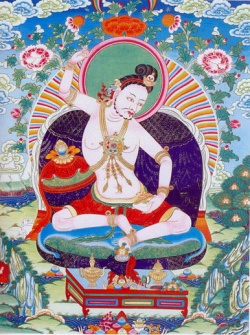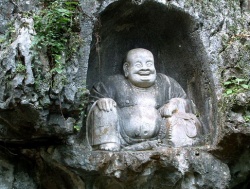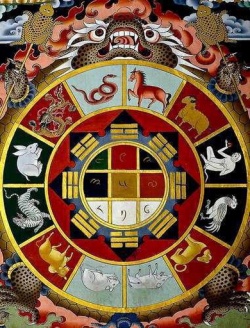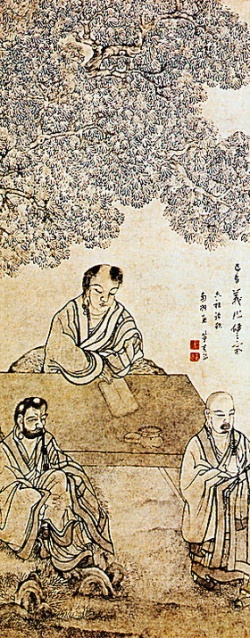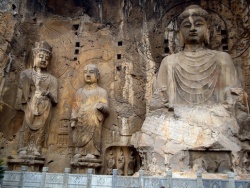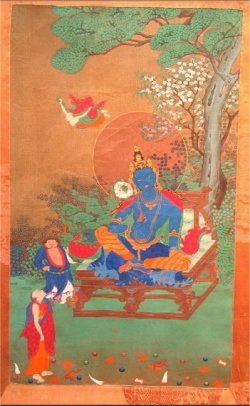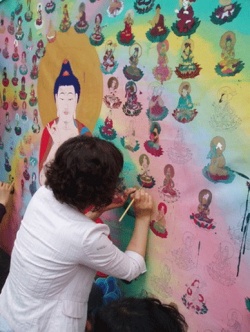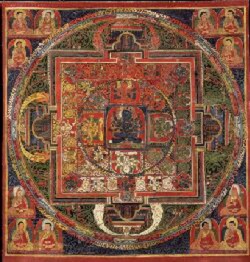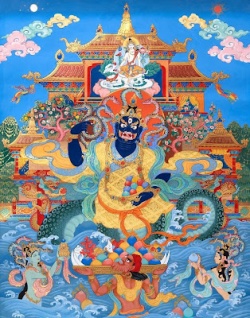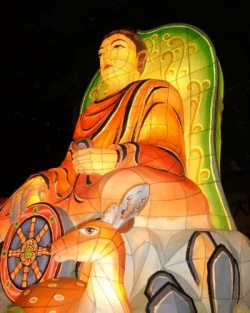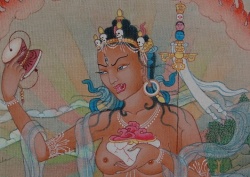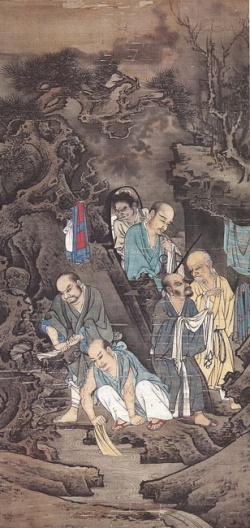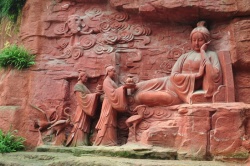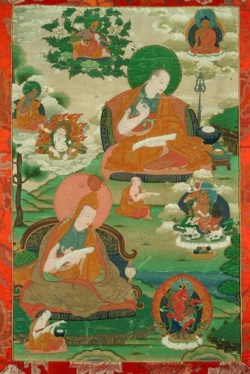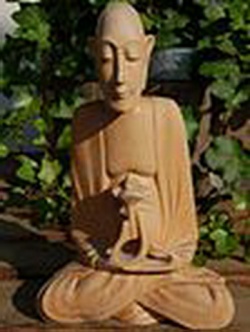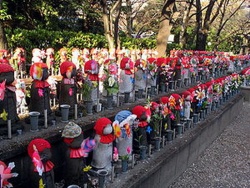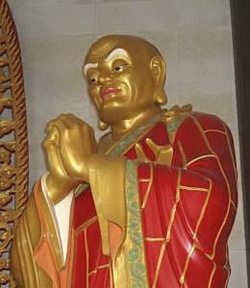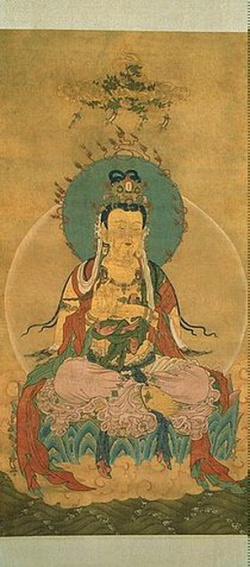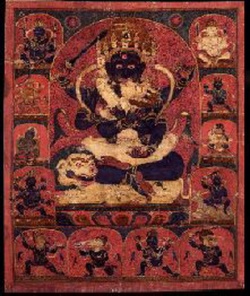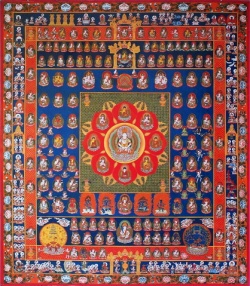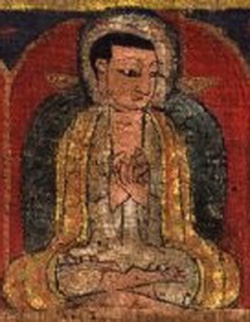The Method of Contemplation on Amida
KANNENBOMON
THE METHOD OF CONTEMPLATION ON AMIDA
THE MERIT OF THE SAMADHI 1)
OF CONTEMPLATION
ON THE OCEAN-LIKE FIGURE2) OF AMIDA BUDDHA
T.47, 22b
Compiled by Bhiksu Shan-tao
Translated by Hisao Inagaki
Part 1
Method of Practicing the Samadhi
1 [Contents of Part 1]
1. Presentation of the method of practicing the Buddha-contemplation Samadhi based on the Contemplation Sutra;3)
2. Presentation of the method of practicing the Nembutsu Samadhi4) based on the Pratyutpanna Samadhi Sutra;5)
3. Presentation of the method of practicing the Nembutsu Samadhi in the meditation hall based on various sutras;
4. Presentation of the method of repenting and making vows in the meditation hall based on the sutras.
[1. Method of practicing the Buddha-contemplation Samadhi)
2 Presentation of the method of practicing the Buddha-contemplation Samadhi based on the Contemplation Sutra: this method is clarified in the Contemplation Sutra and the Sutra on the Ocean-like Samadhi of Contemplation of the Buddha.6)
Contemplate Amida Buddha whose body is the color of pure gold, w{{ith a halo emitting light pervasively and with unparalleled dignity. Aspirants, keep this image, day and night, wherever you are. Keep this image while walking, standing, sitting, or lying down. Always direct your thought to the west and imagine that even the host of sages and all the adornments made of various treasures are manifest before your eyes. This you should remember.
3 Further, aspirants, when you sit in meditation, you should first sit in the full cross-legged posture. Place your left leg on the right thigh, with the sole in harmony with the contours of the body; then, place your right leg on the left thigh, with the sole in harmony with the contours of the body. Rest your right hand on the palm of the left hand, and touch the soft tip of one thumb with that of the other. Next, keep your body upright and close your mouth. Close your eyes so that they appear open but not exactly open, appear closed but not exactly closed.
First, contemplate with your mind's eye the matted hair on the Buddha's head. The skin is the color of gold, and the hair is dark blue. Each hair curls on the head. The skull is snow white and transparent. The brain is the color of crystal. Next, contemplate the brain having fourteen veins, each emitting fourteen rays through the hair-follicles, and contemplate these rays going round the curling hair seven times and returning through the hair-follicles. Next, contemplate the same rays shining forth through the follicles of the eyebrows. Next, contemplate the broad and even forehead. Next, contemplate the high and long eyebrows which look like a new moon. Next, contemplate the white curls of hair between the eyebrows,7) white and void in the interior though appearing to be substantial, and emitting golden light from the tip, which comes right towards you to illuminate you. It is stated in the Sutra on the Ocean-like Samadhi of Contemplation of the Buddha:8)
If practicers contemplate the mark of the white curls of hair even for a moment, they will, whether able to see it or not, be rid of the grave karmic evils which would cause them to transmigrate for ninety-six kotis9) of nayutas10) of kalpas11) multiplied by the number of the sands of the River Ganges.
If you always practice this meditation, you will be rid of a great amount of hindrances and karmic evils. Besides, you will acquire immeasurable merits and so all the Buddhas will be pleased and rejoice.
Next, contemplate the two eyes, broad and long; their black irises and whites are distinct and illuminating light pervades them. Next, contemplate the straight, high nose which looks like a molten gold bar. Next, contemplate the smooth, well-framed face without any trace of scowl. Next, contemplate the ears whose lobes hang low; in the cavity there are seven hairs, each emitting light which illuminates the Buddha's entire body. Next, contemplate the lips, red and resplendent. Next, contemplate the teeth, closely joined to each other and white and bright like a new moon. Next, contemplate the tongue, thin, broad, and long; at the root of the tongue there are two glands which send the saliva through the throat directly to the heart. The Buddha's heart is like a red lotus, open but not altogether open, closed but not altogether closed; it has eighty-four thousand petals, lying one upon another, and each petal has eighty-four thousand veins, each vein emitting eighty-four thousand rays; each ray produces a hundred-jeweled lotus; on each lotus sits a bodhisattva of the tenth [23a] bhumi,12) whose body is of golden color, and each, holding incense and flowers in his hands, worships the Buddha's heart and praises it in chorus. Aspirants, if you practice this meditation, you will be rid of the hindrance and karmic evils and acquire immeasurable merits, so that Buddhas and bodhisattvas will rejoice and heavenly deities and demi-gods, too, will rejoice.
Now, from the heart upward, contemplate the well-framed throat and two shoulders. Next, contemplate the well-framed elbows. Next, contemplate the even, well-framed palms which bear the marks of the thousand-spoked wheel,13) on the ten slim and long fingers, with webs in between, and on the nails of the color of red copper. Again, from the heart upward, contemplate the Buddha's breast, even and well-framed, which bears the clear mark of ten thousand virtues.14) Next, contemplate the abdomen, unfurrowed and not swollen. Next, contemplate the round and deep cavity of the navel, where light always shines inside and out. Next, contemplate the hidden organ, perfect like a full moon and plain and without protuberance like the abdomen and back. The Buddha said:15)
If a man or a woman with too much lascivious desire thinks of the Tathagata's hidden organ, his desire will be quenched, his hindrance and karmic evils removed, and immeasurable virtue attained. Buddhas, then, will rejoice and heavenly deities and demi-gods, too, will rejoicingly follow and protect him. He will, thereby, enjoy a long, peaceful life without the pains of sickness.
Next, contemplate both of the well-framed two thighs, knees, and knee-pans. Next, contemplate the two shins which are like the shanks of the deer king. Next, contemplate the two heels which are like the trunk of the elephant king. Next, contemplate the raised insteps which are like the shell of the tortoise king. Next, contemplate the ten long toes with webs in between and the nails, which are the color of red copper. Next, contemplate the Buddha sitting in the full cross-legged posture; he keeps his left leg on the right thigh, with the sole in harmony with the contours of the body, and his right leg on the left thigh, with the sole in harmony with the contours of the body. Next, contemplate the flat soles bearing the marks of the thousand- spoked wheel; the spokes and rim possess light which universally illuminates the lands of the ten quarters.
The contemplation of the Buddha from the top of the head down to the marks of the thousand-spoked wheel on the soles is called the complete contemplation of the glorious merit of the Buddha's body. This is called the contemplation in the proper order.
4 Next, contemplate the lotus-seat. Then, contemplate the lotus-base. After that, contemplate the petals, lying one upon another to make eighty-four thousand deep. Visualize each petal adorned with a hundred kotis of king-jewels, each jewel possessing eighty-four thousand rays of light which illuminate the Buddha's body above. Next, contemplate the stalk of the jeweled flower with eight sides, each adorned with a hundred thousand jewels which emit great light illuminating all above and below. Next, contemplate the stalk resting on the jeweled ground and the various jewels above the ground which emit eighty-four thousand rays of light, each illuminating the Buddha's body and the six realms16) in the ten quarters.17) Also, imagine that all these rays of light shine upon you. When you practice this meditation, you will be rid of the hindrance and karmic evils and acquire immeasurable merit; therefore, the Buddhas and bodhisattvas will rejoice and heavenly deities and demi-gods, too, will rejoice. Day [23b] and night, they will follow and protect you. You will, thereby, attain peace and security while walking, standing, sitting or lying down. Then you will enjoy longevity in peace and opulence without ever suffering the pains of sickness.
If you follow the Buddha's teaching, you will be able to visualize various things in the Pure Land. If you have perceived them, keep them to yourself and do not talk to others about them. For talking about them is a grave offense that will invite the retribution of a bad illness and shortening of life. If you follow the teaching, you will upon death attain the birth of the highest grade18) in the land of Amida Buddha.
After you have performed this contemplation of the Buddha's body from top to bottom sixteen times, fix your thought on the white curls of hair on the brow. Control your mind well, and do not allow it to be distracted. If it is distracted, you will lose the meditative mind and hardly accomplish the samadhi. This you should remember.
This is the method of practicing the Buddha-contemplation samadhi. If you direct your thought (toward the Buddha) at all times, you will attain birth in the Pure Land. Follow exclusively the Thirteen Contemplations19) of the Contemplation Sutra without apprehension and never entertain doubt.
5 Further I say to the aspirants: If you desire to be born in the Pure Land, you should intently observe the preceptse the nembutsu, and chant the Amida Sutra.20) Chant the sutra fifteen times a day, and you will arrive at ten thousand in two years. Chant it thirty times a day, and you will arrive at ten thousand in a year. Recite the nembutsu ten thousand times a day, and at the proper time21) worship and praise the glorious manifestations of the Pure Land with great effort. Those who (daily) make thirty thousand, sixty thousand, or a hundred thousand utterances are all aspirants of the highest birth of the highest grade. In addition, turn all the other merits toward birth. This you should remember.
I have shown above the method of practicing the Buddha contemplation samadhi.
[2. Method of practicing the Nembutsu Samadhi)
6 The Pratyutpanna Samadhi Sutra, chapter on the Questions,22) clarifies the method of practicing the Nembutsu Samadhi in the meditation hall for seven days and seven nights.
The Buddha said to Bhadrapala,23) "There is a samadhi called 'contemplating all Buddhas of the ten quarters appearing before one's eye.' If you practice this samadhi, you will have answers to all your questions."
Bhadrapala said to the Buddha, "Please explain it to me. Your exposition will serve a great deal to lead people to enlightenment and bring peace to beings of the ten quarters. Please manifest a great illumination for the sake of sentient beings."
The Buddha said to Bhadrapala, "There is a samadhi called 'concentration of thought.' The student should constantly practice it, and never engage in other methods of practice. This is the foremost of all meritorious practices."
7 Next, the sutra states in the chapter on Practice:24).
The Buddha said to Bhadrapala, "If you wish to attain this samadhi quickly, you should always have great resolution. Those who practice it as prescribed can attain it. Do not allow the slightest doubt, even as small as a hair, to creep in. This method for the concentration of thought is called 'bodhisattva practice surpassing all practices'."
Raise the singleness of mind and believe in this teaching.
According to the teaching you have received, think of the (western quarter).
Be mindful and sever all other thoughts.
Make firm resolution and have no doubt.
Be diligent in practice, and be not indolent.
Raise not a thought of being nor a thought of non-being.
Think not of advancing; think not of regressing.
Think not of things before you; think not of things behind you.
Think not of things to your left; think not of things to your right.
Think not of non-being; think not of being.[23c]
Think not of things remote; think not of things nearby.
Think not of painfulness; think not of itchiness.
Think not of hunger; think not of thirst.
Think not of cold; think not of heat.
Think not of suffering; think not of pleasure.
Think not of birth; think not of becoming old.
Think not of sickness; think not of dying.
Think not of living; think not of the span of life.
Think not of poverty; think not of wealth.
Think not of nobleness; think not of baseness.
Think not of lust; think not of greed.
Think not of things small; think not of things large.
Think not of things long; think not of things short.
Think not of beauty; think not of ugliness.
Think not of evil; think not of good.
Think not of anger; think not of joy.
Think not of sitting; think not of rising.
Think not of walking; think not of standing.
Think not of sutras; think not of teachings.
Think not of justice; think not of injustice.
Think not of abandoning; think not of taking.
Think not of ideas; think not of consciousness.
Think not of detachment; think not of attachment.
Think not of voidness; think not of entity.
Think not of lightness; think not of heaviness.
Think not of difficulty; think not of ease.
Think not of deepness; think not of shallowness.
Think not of broadness; think not of narrowness.
Think not of your father; think not of your mother.
Think not of your wife; think not of your child.
Think not of relatedness; think not of estrangement.
Think not of hatefulness; think not of fondness.
Think not of gaining; think not of losing.
Think not of success; think not of defeat.
Think not of purity; think not of turbidity.
Sever all thoughts and be mindful for a fixed period.
Let not your mind be disturbed; be ever diligent.
And count not the years; be not indolent each coming day.
Raise a determined mind; be not lazy mid-way.
Except when asleep, be zealous in your will.
Always live alone and avoid gatherings.
Eschew evil persons, and approach virtuous friends.
Associate with a good teacher and revere him as a Buddha.
Hold fast to your will and ever be supple-minded.
Meditate on equality in everything.
Stay away from your home town and your relatives.
Abandon love and lust and perform pure practices.
Take the way to the Unconditioned25) and sever all desires.
When learning literary wisdom, be sure it complies with dhyana.26).
Get rid of the three defilements.27)
Abandon carnal passions and leave all attachments.
Seek not with a greedy mind to accumulate much wealth.
Learn contentment in eating and be not greedy for tasty food.
Restrain yourself and take no life for food.
Dress yourself as prescribed and decorate not your body.
Ridicule not others; be not proud and haughty.
Be not arrogant; hold not yourself aloof. [24a]
When expounding a sutra, be in accord with the Dharma.
Know that your body is from the beginning like an illusion.
Cling not to the aggregates;28) stand aloof from the dhatus.29)
The (five) aggregates are bandits; the four (elements)30) are snakes.
All are ephemeral, and all momentary.
There is no eternal self; the enlightened know it to be void in itself.
As causes and conditions meet and part, things come into existence and dissolve.
Having realized this well, you will know that all are void from the beginning.
Having pity and mercy for all sentient beings,
Give free gifts to the poor and benefit the needy.
This is the intense concentration; of all bodhisattva practices,
This is the way to the ultimate wisdom, the practice surpassing all."
8 The Buddha said to Bhadrapala, "If you maintain this method of practice, you will attain the samadhi in which all the present Buddhas appear before you. If a bhiksu, bhiksuni, upasaka or upasika31) wants to practice according to the prescribed method, he or she should strictly observe the preceptsl alone in a place, and contemplate Amida Buddha of the western quarter where he lives now. According to the teaching received, you should remember: a hundred thousand kotis of Buddha-lands away from here, there is a land called 'Sukhavati.'32) Contemplate this Land with singleness of mind, for a day and night up to seven days and nights. The seventh day having passed, you will see it. It is as though you see things in a dream without discerning day and night or inside and out; you see them even though they are in the dark and there are many obstacles in between. O Bhadrapala, when the four kinds of Buddhists always do this contemplation, the high mountains, Sumeru mountains,33) or whatever dark places there are in the Buddha-lands (between here and Sukhavati), will all give way and not cause any hindrance. It is not that these four kinds of Buddhists see with a divine eye, hear with a divine ear or reach the Buddha-land with divine feet. It is not that they die here and are born there (in order to see the Land). But they see all this while sitting here."
The Buddha continued, "The four kinds of Buddhists in this land can see it by single- mindedly contemplating Amida Buddha. Now, let it be asked what method of practice they should perform in order to be born in the land. Amida Buddha replies, 'Those who desire to be born should call my Name unceasingly. Then you will attain birth.'"
The Buddha said, "By means of concentrated mindfulness attains birth. Always contemplate the Buddha's body which possesses the ]]thirty-two characteristics]] and eighty minor physical marks and emits billions of rays of light shining everywhere. His majestic countenance is incomparable. He expounds the Dharma in the assembly of bodhisattvas. You must not discard the forms (of the Buddha's body). Why? The reason is that because you do not discard forms, you can contemplate the Buddha's body, and, thereby, attain this samadhi."
I have clarified above the method of Nembutsu Samadhi.
[3. The proper way of entering the meditation hall and exposition of the
method of the Nembutsu Samadhi)
9 When you enter the meditation hall, you should exclusively follow the Buddhist method. First, prepare a hall, place a sacred statue in it, and cleanse it with perfumed hot water. If you have no family Buddha room, any clean room will do. Sweep and wash it clean as prescribed, and place a Buddha's image on the western wall. Aspirants, it would be better if you divide a month into four periods, that is, from the first to the eighth, from the eighth to the fifteenth, from the fifteenth to the twenty-third, and from the twenty-third to the thirtieth. Aspirants, weighing the burden of your occupation, enter the path of the pure act34) at a (convenient) period. From the first to the seventh day, wear only clean clothes and new sandals. During the seven days eat only one meal a day. Let your soft rice cake, plain rice and seasonal pickled vegetable be simple and temperate in quantity.
In the hall, restrain yourself, day and night, and focus your thought on Amida Buddha with uninterrupted, exclusive mind. Let your thought stay in accord with your voice. You are only allowed to sit or stand; do not sleep during the seven days. Also, do not worship the Buddha or recite the sutra. Do not use a rosary, either. Only let the consciousness of your recollection of the Buddha with the joined hands be present, and with every thought, think of seeing the Buddha. The Buddha stated,
Imagine that Amida Buddha's golden body, resplendent with light and incomparably august, resides before your eye.
When you properly contemplate the Buddha while standing, keep standing while you call his Name - from ten thousand to twenty thousand times. When you properly contemplate the Buddha while sitting, stay seated while you call his Name - from ten thousand to twenty thousand times. In the hall, do not join heads and talk with each other.
[4. The proper way of repentance and making vows in the hall and
the manner of tending sick persons]
10 Three or six times each day and night, confess and repent various evils committed through the actions of body, speech, and mind throughout your life to all the Buddhas, all sages, heavenly gods, earth gods, and to all the wardens of the paths of karma.35) Having repented honestly, return to the practice of contemplating the Buddha according to the prescribed method. You should not readily talk about the realm you have seen. If the realm is propitious, keep it to yourself. If it is adverse, repent. Vow that you will not take with the hand or eat with the mouth any wine, meat, or the five kinds of acrid food.36) Vow that if you go against the vow, you will have vicious scabs on your body and mouth. Or make a vow that you will chant the Amida Sutra a hundred thousand times. Repeat the Buddha's Name ten thousand times a day, and chant the sutra fifteen times a day, or twenty or thirty times, according to your capacity. By so doing, desire to be born in the Pure Land and ask for the Buddha's embrace.
11 Again, aspirants, when you are about to die from sickness or otherwise, follow, mind and body, the above-stated method of the Nembutsu Samadhi. Turn your face to the west, and, with concentration of mind, focus your thought on Amida Buddha. Making your mental act agreeable with that of speech, recite (the nembutsu) uninterruptedly, and resolutely think of attaining birth in the Pure Land - and of the sages' coming to receive you. If the sick person sees a realm, let him tell the nursing man about it.
When he has told it, record his story. If the sick person cannot talk, let the nursing man ask him various questions, saying, "What realm did you see?" If he tells of the visions of his karmic evils, let the man on the bed-side recite the nembutsu and repent in order to help the sick man repent; thereby, you can definitely purge him of the karmic evils. If, the karmic evils having been extinguished, he sees the sages on the lotus-base appear before him in response to his nembutsu practice, record it in writing as I have prescribed above. When the aspirant's kinsmen, including six blood relatives,37) come to nurse him, [24C] let not those who have drunk wine or eaten meat or any of the five kinds of acrid food enter (the room). If there is such a man, never allow him to go to the sick man's bed-side. For the sick man may lose his right recollection, be confounded by the spirits, and, after having died in a state of madness, fall into the three evil realms.38) May the aspirants restrain themselves, uphold the Buddha's teachings, and perform the causal practice for seeing the Buddha. The above are the rules for practicing in the hall and for nursing a sick man.
Part 2
Five kinds of merit
12 [Contents of Part 2]
Exposition of the five kinds of superior conditions based on the sutras (one fascicle):
l. Based on the Sutra on the Buddha of Immeasurable Life,39)
2. Based on the Sixteen-Contemplation Sutra,40)
3. Based on the Four-sheet Amida Sutra,41)
4. Based on the Pratyutpanna Samadhi Sutra,
5. Based on the Sutra on the Ten Ways of Attaining Birth (in Amida Buddha's Land);42)
6. Based on the Sutra on the Pure Salvation Samadhi.43)
13 Respectfully, based on Sakyamuni Buddha's teaching, as shown in the six sutras that teach the way of birth in the Pure Land, I will clarify that those who desire to be born in the Pure Land by being mindful of Amida Buddha and calling his Name will, while in the present life, have their lifespans prolonged and escape the nine calamities.44)Details of those benefits will be given in the part below where the five conditions will be explained.
Question: The Buddha urges all sentient beings to awaken the Bodhi-Mind and desire to be born in the Western Land of Amida Buddha. He also urges them to build statues of Amida, praise and worship him, offer incense and flowers to him and contemplate him day and night without interruption. He further urges them to call Amida's Name single-mindedly many times -from ten thousand, twenty thousand, thirty thousand, fifty thousand up to a hundred thousand times. He also urges them to chant the Amida Sutra many times - from fifteen, twenty, thirty, fifty up to a hundred times, and further chant it until they reach a hundred thousand times. If they perform those practices, what benefit will they gain in the present life and what benefit will they gain when their lives, a hundred years at the longest, come to the end? Will they surely attain birth in the Pure Land or not?
Answer: Both in the present life and after death, they will certainly attain great merit and benefit. In connection with this, I will reveal, according to the Buddhist teaching, the causal relations which bring about five kinds of superior benefit. They are: l) the dominant force effecting destruction of one's karmic evils, 2) the dominant force effecting protection and longevity, 3) the dominant force enabling one to see the Buddha, 4) the dominant force of grasping beings, and 5) the superior condition enabling one to attain birth.
14 [1] The dominant force effecting destruction of one's karmic evils:
Those who attain birth on the highest level of the lowest class in the Contemplation Sutra45) have completely committed grave offenses of the ten evils.46) When they become ill and are about to die, they may have a chance to meet a good teacher and receive from him the teaching that urges them to call the Name of Amida Buddha. Each time they recite it, the grave karmic evils which would bind them to transmigration for five billion kalpas will be destroyed. This shows the dominant force effecting destruction of one's karmic evils.
Further, those who attain birth on the middle level of the lowest class47) have committed all sorts of offenses against the Buddha-Dharma, violating the rules of abstinence and other preceptsg properties of the Sangha or utilizing the Buddha-Dharma without repenting or feeling ashamed of such acts. When they become ill and are about to die, a mass of fire of hell besieges them all at once. At that time, they may meet a good teacher, who will tell them about the meritorious physical characteristics of Amida [25a] Buddha and the splendors of his land. No sooner have they heard this, their karmic evils which would bind them to transmigration for eight billion kalpas will be destroyed and [the fire of] hell will disappear. This also shows the dominant force effecting destruction of one's karmic evils.
Further, those who attain birth on the lowest level of the lowest class48) have committed fully the gravest offenses of five deadly acts49) throughout their lives, and so they are destined to hell where they will suffer interminable pain. When they become ill and are about to die, they may meet a good teacher, who will urge them to call the Name of Amida Buddha ten times. With each calling, the heavy karmic evils which would bind them to transmigration for eight billion kalpas will be destroyed. This also shows the dominant force effecting destruction of one's karmic evils.
15 Furthermore, if there are persons who draw paintings of the grandeur of the Pure Land in accordance with the Contemplation Sutra, etc., and contemplate the jewel-ground day and night, the karmic evils which would bind them to transmigration for eight billion kalpas will be destroyed with each contemplating thought. Also, if there are persons who draw paintings [of the Pure Land) in accordance with sutras, and meditate on the splendors of the jeweled trees, jeweled ponds and jeweled towers, their karmic evils which would bind them to transmigration for innumerable kotis of incalculable kalpas will be destroyed in the present life. Further, if one contemplates day and night in accordance with the [prescribed method of]visualization of the splendors of the lotus seat,50) then, while in the present life, one's karmic evils which would otherwise bind one to transmigration for fifty billion kalpas will be destroyed with each contemplating thought. Further, if people practice, in accordance with the sutra, visualization of the image, the true Buddha body, Avalokitesvara and Mahasthamaprapta,51) then, while in the present life, their karmic evils which would bind them to transmigration for innumerable kotis of kalpas will be destroyed with each contemplating thought.
The above references show the dominant force effecting destruction of one's karmic evils.
16 [2] The dominant force providing protection in this life
As stated in the twelfth contemplation,52) if a person concentrates and visualize the two kinds of recompense, i.e., the splendors of Amida's body and the Pure Land, at all times, day and night, wherever he is, then the innumerable transformed Buddhas manifested by Amida Buddha and also innumerable transformed bodies manifested by Avalokitesvara and Mahasthamaprapta will come to this practitioner, even though he may or may not see them. This shows the dominant force effecting spiritual protection in the present life.
Also, it is stated in the Contemplation Sutra:53)
If a person concentrates and is always mindful of Amida Buddha and the two bodhisattvas, then Avalokitesvara and Mahasthamaprapta will be constantly with him, become his good friends and teachers and follow him in his steps just as a shadow follows an object.
This also shows the dominant force effecting protection in the present life.
Further, it is stated in the ninth contemplation54) of the true Buddha body:
Amida Buddha has a body of golden color. The light emanating from the white curls of hair between the eye-brows shines on the sentient beings living in the worlds throughout the ten quarters. The light from each hair-follicle also universally shines on the sentient beings. So does the circle of light about his head. Also the light from each of the eighty-four thousand physical characteristics universally shines on the sentient beings. Each of the lights issuing forth from the physical characteristics mentioned above universally shines on the [25b] worlds throughout the ten quarters. If there are sentient beings who single-heartedly think of Amida Buddhas light always shines on them, embracing and protecting them and never abandoning them.
There is no mention of the light shining on practitioners of the other miscellaneous acts. This also shows the dominant force effecting protection in the present life.
17 Further, it is stated in the Sutra on the Ten Ways of Attaining Birth:
The Buddha said to Mountain-Ocean-Wisdom Bodhisattva and Ananda: "If there is a person who is single-heartedly mindful of Amida Buddha of the west, wishing to be born in his land, I will henceforth dispatch twenty-five Bodhisattvas,55) so that they may, just as a shadow follows an object, protect this practitioner, keep evil spirits and evil devas from tormenting him and thus enable him to dwell in peace during the day and the night."
This also shows the dominant force effecting protection in the present life.
18 Further, it is stated in the Amida Sutra:56)
If there is a man or a woman who single-heartedly and is exclusively mindful of Amida Buddhag to be born in his land, for a period of seven days and nights, or during the whole lifetime, innumerable Buddhas of the six quarters, as numerous as the sands of the Ganges, will come and protect him or her always. For this reason, this sutra is called 'the sutra of protection.'
'The sutra of protection' means that they will also keep various evil spirits and devas from approaching this person and also enable him or her to escape unexpected illnesses and untimely death. Thus all calamities and hindrances will naturally disperse. Excepted, however, are those who lack single-heartedness. This also shows the dominant force effecting protection in the present life.
19 Further, it is stated in the Pratyutpanna Samadhi Sutra, Chapter on Practice:57)
The Buddha said to Bhadrapala, "If there is a person who confines himself in a hall for practicing the Way, dissociating himself from all engagements and single-heartedly contemplates Amida Buddha's body of golden color, for seven days and seven nights, without lying down to sleep, or if a person single-heartedly contemplates the Buddha, recites his Name and is mindful of him, for a day, three days, seven days, or two weeks, five, six or seven weeks, or for a period of a hundred days, or throughout his life, then the Buddha will take him in his embrace. Once he is embraced, he certainly knows that, with his karmic evils destroyed, he will attain birth in the Pure Land."
The Buddha continued, "If a person exclusively practices this Amida-recollection Samadhi, then all devas, the Four Heavenly Guardian Kings,58) and the eight groups of demi-gods, including dragons,59) will follow him like a shadow follows an object and will enjoy seeing him. Thus they will keep various evil spirits, hindrances and calamities from waywardly tormenting and vexing him."
This benefit is explained in detail in the Chapter on Protection. This also shows the dominant force effecting protection in the present life.
20 Further, it is stated in the Abhiseka Sutra, third fascicle:60)
If there is a person who keeps the three refuges61) and the five precepts,62) the Buddha orders Indra,63) the Lord of devas, to dispatch sixty-one heavenly beings to this precept-abiding person so that they may protect him day and night throughout the year and keep various evil spirits from waywardly harassing and tormenting him.
This also shows the dominant force effecting spiritual protection in the present life.
21 Further, it is stated in the Sutra on the Pure Salvation Samadhi:64)
The Buddha said to the Great King Bimbisara, "If there is [25c] a man or a woman who, on the six precept-observing days of the month65)and the eight-king days [of the year],66) confesses any transgressions or faults to deities of the heaven, of the underworld and of all other realms, and seeks to abide by the preceptsn the Buddha will order the kings of the six heavens of the realm of desire67) each to dispatch twenty-five good deities68) to this person, so that they may always follow and protect this precept-abiding person, keep various evil spirits from waywardly tormenting and harming him or her, and enable this person to escape unexpected illnesses, untimely death and calamities, thereby enabling this person to live in peace and comfort at all times."
This also shows the dominant force effecting protection in the present life.
22 Again, I would like to urge you, practitioners: If you, while in the present life, wish to think single-heartedly of Amida Buddha continuously, day and night, single-heartedly chant the Amida Sutra, worship and praise the holy beings who serve as adornments of the Pure Land, thereby wishing to attain birth there, and if you daily chant the sutra fifteen times, twenty or thirty times or more, or if you are chanting it forty, fifty, a hundred times or more, then you should strive to chant it a hundred thousand times. Also glorify and worship the two kinds of splendors of Amida's Pure Land, i.e., the dependent and principal rewards. Also, except when you are in the meditation hall, call Amida's Name without interruption for ten thousand times a day, until your life ends. If you do so, you will receive the benefit of Amida's remembrance, and the hindrances of your karmic evils will be eliminated. Also you will receive the benefit of constant accompaniment, protection and remembrance by Amida and holy beings, so that your life-span will be extended and you will enjoy a long life in peace and comfort. Detailed accounts of the benefit are given in the Parable Sutra,69) the Sutra of Samadhi on the Contemplation of Nothingness,70) the Sutra on the Pure Salvation Samadhi, etc. This is further evidence of the dominant force effecting protection in the present life.
23 [3] The dominant force enabling one to attain the Buddha-visualization Samadhi
It is stated in the Contemplation Sutra:71)
The queen of Magadha, named Vaidehi, while dwelling in the palace, always desired to see the Buddha. Facing towards the Vulture Peak, she wept with grief and bowed in worship. The Buddha, knowing this from afar, disappeared from the Vulture Peak and manifested himself in the palace. Upon raising her head, the queen saw the Buddha. His body was the color of purple gold, and he was sitting on a jeweled lotus throne, attended by Maudgalyayana and Ananda on his left and right. Above him in the sky were Sakra72) and Brahma,73) scattering flowers as offerings. Having seen the Buddha, the queen threw herself on the floor, wept bitterly and pleaded and repented herself to the Buddha, saying, "I pray, O Tathagata, please teach me how to visualize the land of pure karmic perfection."
By this scriptural evidence is shown not only that through sincerity of heart the queen was able to see the Buddha, but also that the method [of Buddha contemplation] was expounded for the sake of ordinary people of the future. If there is a person who cherishes a desire to see the Buddha, he should sincerely think of the Buddha as the queen did. Then there is no doubt that he will see him. It is due to Amida Buddha's three mindful Vow-Powers working on this person from outside that he will be able to see the Buddha. The three powers, according to the Pratyutpanna Samadhi Sutra,74) are as follows:1) Because [the Buddha) remembers this person with the great Vow-Power, he is able to see the Buddha; 2) because [the Buddha) remembers him with the Samadhi-Power, he is able to see the Buddha; and 3) because [the Buddha) remembers him with the original Merit-Power, [26a] he is able to see the Buddha.This significance will be further exemplified below when the dominant force enabling one to see the Buddha are explained. This is called the dominant force enabling one to attain the Buddha-visualization Samadhi.
24 Question: Since the queen had a strong and superior merit-power, she was able to see the Buddha. How can sentient beings of the last Dharma age,75) who have deep and heavy karmic evils, be compared with the queen? As this implication is extremely profound and broad, please show me clear evidence by quoting extensively from the Buddhist sutras.
Answer: The Buddha is a sage of the three transcendental knowledges,76) possessed of the six supernatural powers77) which know no obstructions. After observing the people's capacities, he gives them [appropriate] teachings. Whether the teaching [one practices] is shallow or deep, if only one devotes oneself sincerely to it, there is no doubt that one will see [the Buddha). It is stated in the Contemplation Sutra:78)
The Buddha praised Vaidehi, saying: "It is good that you have asked me about this matter. Ananda, keep the Buddha's words and expound them widely to the multitudes of beings. I, the Tathagata, will teach Vaidehi and all sentient beings in the future how to contemplate the Western Land of Utmost Bliss. Through the Buddha's Vow-Power they will be able to see that land as clearly as if they look into a clear mirror and see their own images in it."
This quotation from the sutra is further evidence showing that, due to Amida Buddha's three powers working from outside, one is able to see the Buddha. Hence, we call this the dominant force enabling one to attain the samadhi of seeing the Buddha and the Pure Land.
25 Further, it is stated in the Contemplation Sutra:79)
The Buddha said to Vaidehi: "You are an ordinary person, and your mental faculty is inferior, and so you are not able to see far. Buddhas, Tathagatas, with a special expedient enable people like you to see [the Pure Land)." The queen said to the Buddha, "Now I have seen the Buddha's Land through his power. How can sentient beings, who come after the Buddha's death and, being defiled and evil, are tormented by the five pains,80) see the Land of Utmost Bliss?"81) The Buddha said, "Vaidehi, you and other sentient beings should single-mindedly fix your thoughts and contemplate the lapis lazuli ground of the Western Land, all the jewel-bannered pillars under it, manifold jewels on the ground, decorations inside the buildings, etc."
If one single-mindedly concentrates one's thought, one will be able to see [the Pure Land) just as the queen saw it, as stated above. Hence, it is said:82)
Visualize them very clearly, one by one, so that you can see them whether you close your eyes or not. If you have accomplished this contemplation, it is said that you have roughly seen [the Pure Land).
As this is a visualization in the state of conscious thought, it is said 'roughly seen.' If you have attained a meditative samadhi or a recitation samadhi, your mind's eye will open and you will see with it all the splendors of the Pure Land, which no words can fully describe. This quotation from the sutra is further evidence. All ordinary beings can certainly see [the Pure Land) if only they concentrate their thoughts. You should realize this. If you have heard of someone who has seen [the Pure Land), you should not be surprised or entertain doubt. The reason is that, due to Amida Buddha's Samadhi-Power working on him from outside, he can see it. For this reason, we call this the dominant force enabling one to attain the samadhi of seeing the Buddha's Pure Land.
26 Further, it is stated further down in the contemplation of the lotus seat:83)
The Buddha said to Ananda and Vaidehi: "I will teach [26b] you a method of removing suffering. You should discern and expound it to multitudes of beings." When those words were uttered, the Buddha of Infinite Life, Avalokitesvara and Mahasthamaprapta responded to them by appearing in person and standing in the midair. Seeing them, Vaidehi worshiped them. After worshiping them, she said to the Buddha: "Now I have seen the Buddha of Infinite Life and the two Bodhisattvas through the Buddha's power. How can sentient beings who come after the Buddha's death see Amida Buddha and the two Bodhisattvas?" The Buddha said: "If you and other sentient beings wish to see that Buddha, you should concentrate and form an image of a lotus flower. When you have formed an image of a lotus flower, you should next imagine the Buddha. When you imagine the Buddha, let your thought form his image with thirty-two physical characteristics. Imagine parts of his body, one by one, from the top of the head down to the cross-legged posture. In correspondence with your contemplating thought, the Buddha will manifest his body."
This shows that, due to Amida's three powers working from outside, one is able to see the Buddha. This, again, is called the dominant force enabling one to attain the Buddha-visualization Samadhi.
27 Further, it is stated in the Contemplation Sutra below:84)
When you perceive the Buddha, you should first perceive his image. Perceive a golden image sitting on the lotus flower. When you have seen this, your mind's eye will open, and with it you will be able to see clearly and distinctly all the splendors of that Land.
This shows that, due to Amida's three powers working from outside, one can see the Buddha. This is called the dominant force enabling one to see the Buddha.
Further, it is stated in the Contemplation Sutra below:85)
Next, perceive the two Bodhisattvas and various forms of light. See them clearly. When you have seen them, you, the practitioner, will be able to hear in the samadhi the flowing water, light, adornments, and so forth, proclaiming the Dharma. Whether in or out of the samadhi, you will be able to hear the excellent Dharma always.
This also shows that, due to Amida's three powers working from outside,one is able to see the Buddha. This is called the dominant force enabling one to attain the Buddha-visualization Samadhi.
28 Further, it is stated [in the Contemplation Sutra) below in the section on the visualization of the true body:86)
The Buddha said to Ananda: "When you have accomplished the contemplation on the image, next perceive the Buddha of Infinite Life. His body is of the color of genuine gold. Perceive and see with your mind's eye the white curls of hair between the eyebrows, the circle of light, the transformed Buddhas and the rays of light which shine forth from his physical characteristics and minor marks of excellence. When you have seen them, you will be able to see all Buddhas of the ten quarters. Hence, this is called Buddha-contemplation Samadhi."
This passage is further evidence showing that, due to Amida Buddha's three powers working from outside, one is able to see the Buddha. Hence, this is called the dominant force enabling one to attain the Buddha-visualization Samadhi.
Further, it is stated in the Contemplation Sutra below:87)
The Buddha said: "For this reason, a wise person should single-mindedly and clearly perceive the Buddha of Infinite Life. You should enter into the contemplation through one of his physical marks. One who clearly perceives the white curls of hair between the eyebrows will spontaneously perceive all the eighty-four thousand physical marks. Having seen them, he will see [26c] all the Buddhas of the ten quarters and personally receive from each of them the prediction of his attainment of Buddhahood."
This passage of the sutra also testifies that, due to Amida Buddha's three powers working from outside, the ordinary beings who single-mindedly meditate on him are definitely enabled to see the Buddha. This is also called the dominant force enabling one to attain the Buddha-visualization Samadhi.
29 Further, [we find similar expositions in the sections on] contemplation of Avalokitesvara, Mahasthamaprapta, the over-all aspect, miscellaneous aspects, etc., and also below in the section on the nine grades of aspirants:88)
Those who practice throughout their lives or practice even for seven days, one day, or call the Name ten times or even once, desiring to see the Buddha at the time of death, - if they meet good teachers in this life and think of Amida Buddha and call his Name, the Buddha will appear before them with a host of sages, holding lotus pedestals. The practitioners will see the Buddha and also the host of sages and the lotus pedestals.
This passage of the sutra also testifies that, due to Amida Buddha's three powers working from outside, one is able to see the Buddha. Hence, we call this the dominant force enabling one to attain the Buddha-visualization Samadhi.
30 Further, it is stated in the Contemplation Sutra below:89)
The Buddha said to Ananda: "This sutra is called the Sutra of Contemplation of the Land of Utmost Bliss, the Buddha of Infinite Life and Avalokitesvara and Mahasthamaprapta Bodhisattvas. You should hold this and not forget this. Those who practice this samadhi will be able to see in the present life the Buddha of Infinite Life and the two Bodhisattvas."
This passage of the sutra also testifies that, due to Amida Buddha's three powers working from outside, ordinary beings who meditate on him are made to avail themselves of their own three-mind power and are, therefore, enabled to see the Buddha. [The aspirants'] sincere mind, believing mind and aspiring mind are the internal cause; and Amida's three kinds of Vow-Power on which they depend are the external condition. Through the coordination of the external condition and the internal cause one can see the Buddha. Hence, this is called the dominant force enabling one to attain the Buddha-visualization Samadhi.
31 Further, it is stated in the Pratyutpanna Samadhi Sutra:90)
The Buddha said to Bhadrapala Bodhisattva: "There is a samadhi called 'all Buddhas of the ten quarters appearing before one's eye'. If you wish to attain this samadhi quickly, you should always hold fast to it and not allow doubt, even as minute as a hair, to creep in. If monks, nuns, laymen and laywomen wish to practice this samadhi, they should keep awake for seven days and nights and keep their minds free of all distracting thoughts. They should concentrate on one point, that is, meditate on the body of Amida Buddha of the West, which is of the color of genuine gold and possesses thirty-two characteristics; his body emits penetrating light and is incomparably majestic."
If they single-mindedly contemplate with uninterrupted thoughts and practice oral recitation [of his Name), the Buddha says:
They will see him after seven days. It is like observing stars at night. Let us suppose one star is one Buddha. Anyone of the four groups of Buddhists who practices this meditation can see all the Buddhas just as they see all the stars.
The passage of this sutra also testifies that, due to Amida Buddha's three powers working from outside, one can see the Buddha. 'Samadhi' means that the Nembutsu practitioners think [of the Buddha) in their minds and [27a] recite [his Name) with their mouths, without having miscellaneous thoughts; if the thoughts [of the Buddha) continue to be present in their minds and the utterances [of the Name) follow one after another, their mind's eyes will open and they will see the Buddha manifest himself clearly. This is called concentration and is also called samadhi. When one sees the Buddha properly, one also sees the host of sages and various adornments. Hence, this is called the dominant force enabling one to attain the samadhi of visualizing the Buddha and the Pure Land.
32 Further, it is stated in the Moon-Lamp Sutra:91)
If one meditates on the Buddha's physical characteristics and his virtuous conduct, keeps one's senses from being disturbed and keeps one's mind free of delusion and in agreement with the Dharma, then what one can learn by hearing and what one can know will be like the great ocean. If a wise person dwells in this samadhi and performs practices while keeping his thoughts well under control, then he will be able to see, at the place of his walking practice, a thousand kotis of Tathagatas and also meet Buddhas as numerous as the sands of the River Ganges.
The passage of this sutra is further evidence. This is also called the dominant force enabling one to attain the Buddha-visualization Samadhi.
33 Further, it is stated in the Manjusri Prajnaparamita Sutra:92)
Manjusri said to the Buddha: "Why is it called 'Single Practice Samadhi'"?93) The Buddha replied: "If a man or a woman, while dwelling at a quiet place, discards all distracting thoughts and, facing towards the place where the Buddha resides, sits in the proper upright position; then, without forming in the mind any image [of the Buddha), he or she single-mindedly recites his Name. If the recitation continues uninterrupted, then he or she will be able to see in the recitation practice all the Buddhas of the past, present, and future."
The passage of this sutra is further evidence testifying that one can see the Buddhas, due to the working of their thought powers, which arise from 'the great compassion of looking on all as of the same body as oneself'. This is again the dominant force enabling ordinary beings to attain the Buddha-visualization Samadhi.
34 [4] The dominant force of embracing beings in the light
One of the Forty-eight Vows94) in the Sutra on the Buddha of Infinite Life says:
The Buddha said: "If, when I become a Buddha, the sentient beings of the ten quarters who desire to be born in my land and say my name even ten times should not be born there through my Vow-Power, then may I not attain perfect enlightenment."
This shows that the practitioners aspiring for birth, when they die, are enabled to attain birth by being embraced by the Vow-Power. Hence, this is called dominant force of embracing beings.
Further, it is stated in the same sutra, fascicle 1:95)
Those beings who attain birth in the Western Land of the Buddha of Infinite Life all avail themselves of Amida Buddha's karmic power, such as the Great Vow, as the dominant force [for that purpose].
This is further evidence. This is indeed the dominant force of embracing beings.
Again, it is stated in the same sutra, fascicle 2:96)
The Buddha said: "All sentient beings are different in their spiritual capacities, and so they may be divided into upper, medium and lower classes. The Buddhas all urge them to say the Name of the Buddha of Infinite Life single-heartedly, each according to his own spiritual capacity. When their lives end, the Buddha personally comes to welcome them with a host of sages and enable them all to attain birth."
This also shows the dominant force of embracing beings.
35 Further, it is stated in the Contemplation Sutra, sections on the first eleven contemplations97) and the nine grades of aspirants98) below, which are all the Buddha's own exposition: When those who perform either meditative or non-meditative practices die, Amida, the World-Honoured One, [27b] will come to each one of them in person with a host of sages, offering his hands to help him mount a lotus-dais and thus welcoming him to be born [in the Pure Land). This also shows the dominant force of grasping beings.
36 Further, it is stated in the Four-sheet Amida Sutra:99)
The Buddha said: "If a man or a woman single-heartedly and exclusively recites Amida's Name for one to seven days, when his or her life is about to end, Amida Buddha will come in person to welcome him or her, thus enabling him or her to be born in the Western Land of Utmost Bliss." Sakyamuni Buddha continued: "As I see this benefit, I have spoken these words."
This is further evidence. This shows the dominant force of embracing beings.
37 Further, it is stated in one of the Forty-eight Vows:100)
If, when I become a Buddha, those sentient beings of the ten quarters who awaken the Bodhi-Mind, perform various meritorious practices and desire with sincerity of heart to be born in my Land, should not, when they die, see me appearing before them with a host of sages, then may I not attain the perfect enlightenment.
This again shows the dominant force of embracing beings.
Further, another Vow below101) says:
If, when I become a Buddha, those sentient beings who, having heard my Name, fix their thoughts on my Land and turn their merits towards it, aspiring for birth in my Land, should not fulfill their desire, then may I not attain perfect enlightenment.
This again shows the dominant force of embracing beings.
Further, still another Vow below102)says:
If, when I become a Buddha, those women in the worlds of ten quarters who, having heard my Name, rejoice in serene faith, awaken the Bodhi-Mind and seek to abandon women's bodies, should, after their death, be born again as women, may I not attain perfect enlightenment.
The meaning of this vow is that, due to Amida's Power of the Primal Vow, those women who call the Buddha's Name will, at their death, be transformed into manhood; Amida will take their hands and bodhisattvas will hold their bodies to enable them to sit on the jeweled lotus-daises. Then, following the Buddha, they will be born in his Land, join the Buddha's great assembly and realize the insight into the non-arising of all things. Again, unless they rely on Amida's Name and Vow-Power, women will not be able to leave their female bodies even after a thousand or ten thousand kalpas or a period of kalpas as innumerable as the sands of the River Ganges. If a monk or a layman says that women will not be able to be born in the Pure Land, this person is telling a lie. You should not believe him. The above quotation of the sutra is further evidence. This also shows the dominant force of embracing beings.
38 [5] The dominant force in realizing one's birth in the Pure Land
Question: You have said that Amida's Forty-eight Vows embrace all sentient beings and enable them to be born in the Pure Land. It is not yet clear what sort of sentient beings attain birth and who testifies to their birth.
Answer: It is stated in the Contemplation Sutra:103)
The Buddha said to Vaidehi: "Do you know that Amida Buddha is not far from here? You should fix your thoughts and visualize that Land. Then your pure act will be accomplished. I will also enable [27c] all ordinary beings of the future to attain birth in the Western Land of Utmost Bliss."
The above passage of this sutra is further evidence. If ordinary beings who will come after the Buddha's death take advantage of Amida Buddha's Vow-Power, they will definitely attain birth. This indeed shows the dominant force enabling one to attain birth.
39 Question: Sakyamuni's sermons were meant to enlighten sentient beings. Why are there people who believe in them and those who do not, each abusing the other?
Answer: Moral natures of ordinary persons are of two kinds: good nature and evil nature. Those of good nature are again of five kinds: 1) good persons who, having heard the teaching, abandon evil and do good; 2) good persons who abandon the wrong and perform the right; 3) good persons who abandon the untrue and perform the true; 4) good persons who abandon the unrighteous and perform the righteous; and 5) good persons who abandon the false and perform the true. Those five kinds of persons are able to benefit both themselves and others if they take refuge in the Buddha. At home they perform filial duties; outside, they bring benefit to others. Among the people, they perform sincerity; in the imperial court, they are called 'gentlemen,' being loyal to the king and bent on fulfilling their duties as loyal subjects. Hence, they are called persons who are good in their own nature.
Persons of evil nature are: 1) evil persons who slander the true and engage in the false; 2) evil persons who slander the right and engage in wrong-doings; 3) evil persons who slander the righteous and engage in unrighteous deeds; 4) evil persons who slander the true and engage in the untrue; and 5) evil persons who slander good and engage in doing evils. Even if those five kinds of persons wish to take refuge in the Buddha, they are not able to attain their own benefit, nor bring benefit to others. At home they do not perform filial duties; among the people, they have no sincerity.
At the court, they are called 'petty-spirited persons'; when they serve the king, they always entertain flattery and insidious thoughts; hence, they are called 'disloyal persons.' Furthermore, in their attitudes towards wise, virtuous and good people, those persons deny righteousness and fabricate unrighteousness; they see only evils in others. Hence, they are called persons who are evil in their own nature. All the good and righteous people among human and heavenly beings as well as Buddhas and sages are slandered and shamed by those evil persons. Wise people should be aware of this. I have above given detailed explanation of the persons of good nature and those of evil nature, thereby clarifying the way things are. I have thus answered your question.
40 Further, it is stated in the Contemplation Sutra below:104)
The Buddha said to Vaidehi: "You and other sentient beings should concentrate and fix the thoughts on one point, contemplating the golden bannered pillars under the ground of the Western Pure Land and also the various jeweled adornments above it.
From here to the end of the thirteenth contemplation is generally [the Buddha's) reply to Vaidehi's two requests as mentioned above. This is clear evidence of the fact that Sakyamuni Buddha desired to rouse good and evil ordinary persons to convert their thoughts and perform practices so that they might all attain birth. This also shows the dominant force enabling one to attain birth.
Further, it is stated in the Contemplation Sutra below:105)
In the land made of various jewels there are five hundred kotis of jeweled towers. In those jeweled towers there are innumerable heavenly beings, who play heavenly music and proclaim in it [28a] mindfulness of the Buddha, Dharma, and Sangha. If you have accomplished this contemplation, you will, after death, surely be born in his Land.
This passage of the sutra is further evidence. This also shows the dominant force enabling one to attain birth.
Further, it is stated in the Contemplation Sutra below:106)
The Buddha said to Ananda: "This wondrous flower has originally been produced by Dharmakara Bhiksu's Vow-Power. If you want to contemplate on that Buddha, you should first form an image of this flower-seat. Contemplate on each part of it until you can see the whole thing clearly. If you have accomplished this meditation, you will definitely be born in the Land of Utmost Bliss."
This passage of of the sutra is further evidence. This again shows the dominant force enabling one to attain birth.
41 Further, it is stated in the Larger Sutra:107)
The Buddha said to Ananda: "If sentient beings have been born in his Land, they all join the group of the right established state. All the Buddhas of the ten directions praise that Buddha. If sentient beings, having heard his Name, rejoice with a heart of absolute trust and think of him even once, desiring to be born in his Land, then they will attain birth and dwell in the stage of non-retrogression."
This passage of the sutra is further evidence. This also shows the dominant force enabling one to attain birth.
42 Further, it is stated in the Contemplation Sutra, section on the nine grades of aspirants, that the sentient beings mentioned in each grade are ordinary persons of the period of the five defilements108) when the Buddha was still in the world and after his death. They may meet good teachers, who urge them to awaken faith, observe the preceptsk of the Buddha, chant sutras, worship and praise him, and then they will definitely attain birth. Due to the Buddha Vow-Power they will all attain birth. This again shows the dominant force enabling one to attain birth.
43 Further, the Amida Sutra says [to the effect]:109)
There are in each of the six quarters Buddhas as numerous as the sand-grains of the River Ganges. They all produce tongues, covering the entire universe with them and proclaiming the words of sincerity and truth: 'All ordinary persons, whether they live during the time of the Buddha or they come after his death, should convert their thoughts and think of Amida Buddhag to be born in his Pure Land, and call his Name continuously until their lives of a hundred years, at the longest, come to an end, or call his Name for seven days, one day, or even ten times, three times or only once. When they die, the Buddha will come to the aspirants in person with a host of sages and welcome them, thus enabling them to attain birth.
Those Buddhas of the six quarters manifested broad tongues and gave testimony to ordinary persons that their karmic evils would be destroyed and they would attain birth. If, in spite of the testimony, they should not be born, the Buddhas' tongues that were manifested out of their mouths would not have returned to their mouths and would have naturally decayed and perished. This also shows the dominant force enabling one to attain birth.
44 Respectfully I urge you, all aspirants: When you have heard those words, you should accordingly shed tears of anguish like rain and resolve to repay your indebtedness to the Buddhas even by grinding your bodies into powder and breaking your bones for many kalpas to come. Then you will come into accord with their original intent. Why should there be doubt, even as minute as a hair, which keeps you from accepting these words? I also urge you, all followers of the Way: All ordinary persons of karmic evils can still have their evils destroyed and realize attainment of birth; [28b] how much more so with sages? How could they desire birth and yet fail to reach [the Pure Land)?
I have summarily answered the question as to what sort of sentient beings can be born in the Pure Land. Here ends my explanation of the five kinds of dominant force.
Part 3
Recommendation of the Pure Land practice
[1. First question and answer]
45 Question: Sakyamuni appeared in the world and, in order to save ordinary people in the age of five defilements, compassionately explained the painful aspects of the three evil realms which people undergo as a result of the ten evil acts. Also, with the wisdom of equality, he led human beings and devas to turn their thoughts110) and attain birth in the Land of Amida Buddha. In various sutras there are clear references to this teaching of quick enlightenment. Now there are people who openly express their disbelief of it and compete with each other in abusing it. I do not know what retribution such people will receive in the present life and after death. Please give me scriptural evidence for their sake by quoting fully from sutras, so that I may benefit them by leading them to repent, believe in the Buddha's Mahayana teaching, turn their minds and attain birth in the Pure Land.
Answer: If I am to answer your question based on sutras, such evil persons are those that I described above in the section on the five evil natures.111) I will now reveal a quotation directly from a sutra as clear evidence.
It is stated in the Sutra on the Ten Ways of Attaining Birth:
The Buddha said to Girisagarajna112) Bodhisattva, "You should hold this teaching for the purpose of saving all sentient beings."
The Buddha further said to Girisagarajna Bodhisattva, "This sutra is called the 'Sutra on the Samadhi of Right Mindfulness and Emancipation through Contemplation of Amida Buddha's Physical Body.' It is also called the 'Sutra of Saving Sentient Beings of Close Karmic Relations Who are Subject to the Eight Adverse Conditions113) in Samsara.' You should hold this teaching as such. For those sentient beings who have not yet had good karmic relations with the Nembutsu Samadhi, this sutra opens the great samadhi-gate. This sutra closes the gate of hell for the sake of sentient beings. Also, for the sake of sentient beings, this sutra keeps away those who inflict harm on them and destroys evil spirits, thereby giving peace to all beings in the four directions."
The Buddha said to Girisagarajna Bodhisattva, "This is the meaning of my exposition."
Girisagarajna said to the Buddha, "Many sentient beings of the future may abuse [this teaching). What will be the outcome?"
The Buddha said, "In future there will be in Jambudvipa114) monks and nuns, men and women, who, having seen someone chanting this sutra, will get angry with this person and entertain enmity in their minds. By the cause of abusing the right Dharma, they will in the present life suffer from bad and serious illnesses or have impaired limbs; or they will be deaf, blind, or dumb;115) or they will suffer from harassment by evil spirits, insanity, colds, fever, piles, dropsy or loss of consciousness. These bad and serious illnesses will beset their bodies life after life. Suffering thus from pains, they will not find rest, whether sitting or lying; they will be unable to ease nature. However strongly they may seek death or life, they will get neither. All such pains result from abusing this [28c] sutra. It happens that, after death, they will fall into hell, where they will undergo extreme pains for eighty thousand kalpas, and will not be able to hear even the words 'water' or 'food' for thousands of millions of lives to come.
These are the karmic retributions they will get by their acts of abusing this sutra. It so happens that when they can come out of hell to be born in the human world, they will be born as oxen, horses, boars or sheep and end their lives in great pain by being slaughtered by men. This is due to abusing this sutra. Later, when they are born again as human beings, they will always be born in low-class families, unable to enjoy freedom for thousands of millions of lives, or unable to see even the words denoting the Three Treasures for thousands of millions of lives. Such is the painful result one receives by the act of abusing this sutra. For this reason, you should not expound it to ignorant people. Only to those people who possess right contemplation and right mindfulness should you expound this sutra. If one does not revere this sutra, one will fall into hell. If one reveres it, one will attain right emancipation and be born in the Land of Amida Buddha."
I have quoted this sutra as evidence. Hence, I know that those who abuse it and those who revere it will unfailingly receive retribution and reward, respectively, as the Buddha predicted. This you should know.
[2. Second question and answer]
46 Question: After the Buddha's death, ordinary people, whether good or evil, who will awaken Bodhi-Mind and aspire to be born in the Land of Amida Buddhay apply their mindsy and night, until the end of their lives, to reciting [his Name), meditating [on him], worshiping and praising him, and offering incense and flowers to Amida, Avalokitesvara and other sages, and also to the glorious adornments of the Pure Land. With continuous contemplation, they may or may not attain the samadhi. What sort of merit will accrue to such people? Please give me scriptural evidence by quoting fully from sutras, so that I may lead the practicers who follow the teaching to attain joy and appreciation, receive it in faith and uphold it.
Answer: It is good that you have asked me this question. It will lead to the termination of causal acts - for cycles of birth and death in the six realms - and forever open the essential gate for the Pure Land of eternal bliss. Not only does your question comply with Amida's Vows, but also all Buddhas are pleased with it. Now, based on a sutra, I will answer your question in detail.
It is stated in the Pratyutpanna-samadhi-sutra:116)
The Buddha said to Bhadrapala, "Concerning this Nembutsu Samadhi, there are four things to offer up [to Amida): food, clothes, bed and medicinal drink. They serve as an aid [to the accomplishment of the samadhi) and produce joy.117)All the Buddhas of the past attained enlightenment by keeping in mind this Amida-recollection Samadhi and performing the joy-giving act of offering four things as the auxiliary practice. Present Buddhas of the ten quarters, too, have all attained enlightenment by keeping in mind this Nembutsu Samadhi and performing the joy-giving act of offering four things as the auxiliary practice. Buddhas of the future, too, will attain enlightenment by keeping in mind this Nembutsu Samadhi and performing the joy-giving act of offering four things as the auxiliary practice."
The Buddha said to Bhadrapala, "Concerning this Nembtsu Samadhi and the joy-giving act of offering four things as the auxiliary practice, I will present a simple illustration connected with this samadhi, thereby showing by comparison the merit of recollection of the Buddha. Suppose there is a man who is one hundred years old. From the time of his birth he runs fast. Until he becomes old, he keeps running faster than the swift wind. Is there anyone who can calculate the distance he has traveled?"
Bhadrapala replied, "No; no one can calculate it."
The Buddha said, "I will further demonstrate to you and other bodhisattvas. Suppose a good man or woman acquires rare treasures which fill the space this man has covered and then donates them to charity. The merit of the donation cannot be compared with that of a person who hears of this Amida-recollection Samadhi and performs the joy-giving act of offering four things as the auxiliary practice. This person's merit is thousands of [29a] millions of times as much as that of the donor. It is indeed impossible to compare."
The Buddha continued, "In ancient times, incalculable and immeasurable kalpas ago, there lived a Buddha called Simhamati118) in the country named Bhadrapala. There was a cakravartin king called Visesagamin.119) One day the king went to see the Buddha. Knowing the King's intention, the Buddha expounded to him the Nembutsu Samadhi and the joy-giving act of offering four things as the auxiliary practice. Having heard the exposition, the King rejoiced and immediately donated various rare treasures to the Buddha. The king himself vowed that with the merit of this act he would make all human beings and devas live in peace."
The Buddha said, "When the king died, he was born again into the same family as a prince called Brahmadatta.120) At that time there was a monk, Ratnottama121) by name. He always taught the Nembutsu Samadhi to the four groups of his disciples. When the King heard the teaching, he performed the joy-giving act of offering four things as the auxiliary practice, donating treasures to the monk. He also offered clothes to him. The King and his thousand royal subjects renounced the world to become mendicants under the monk. Intent on learning the Nembutsu Samadhi, the King always served the monk and the thousand mendicants. For eight thousand years he practiced day and night without feeling fatigue. When he once heard an exposition of the Nembutsu Samadhi, he instantly attained the superior wisdom. After that he further went to see sixty-eight thousand Buddhas and, at the place of each Buddha, learnt this Nembutsu Samadhi. Then he attained Buddhahood."
The Buddha said, "Even if there is a distance of a hundred li, a thousand or four thousand li to travel to hear an exposition of this Nembutsu Samadhi, you should go and seek it. How much more so if there is only a short distance to travel."
I say to you, aspirants of the Pure Land, that the Buddha's teaching quoted above is clear evidence. Details are given in the chapter on 'The Merit of Offering Four Things.'122)
[3. Thirdt question and answer]
47 Question: One may practice assiduously and painstakingly in accordance with the Buddha's teaching, namely, worshiping, reciting [the Buddha's Name) and walking around [a statue of the Buddha) six times during the day and the night, contemplating the Buddha and chanting sutras; one may also observe the precepts with singleness of mind, abhor birth-and-death and, fearful of the suffering in the three evil realms, aspire to be born in Amida Buddha's Pure Land after the end of life. However, such a person may perhaps still have some lingering evil karma, and so may actually be engaged in the ten evil acts. If one becomes aware of such hindrances, how can one remove them? Please show me the method by quoting fully from sutras.
Answer: If I am to answer your question based on sutras, I may quote the Sutra on the Ocean-like Samadhi of Contemplation of the Buddha.123)
The Buddha said to his father, the King, and multitudes of people: "In the past there was a Buddha named Sunyaraja.124) During the period of the Semblance Dharma125) there were four monks who broke the precepts and committed grave offenses. At that time Sunyaraja Buddha addressed the four monks from mid-air at night, saying, 'Your offenses are called 'incapable of salvation.' If you want to eliminate your karmic transgressions, go into the stupa built for me, and, contemplating my statue, repent with sincerity of heart. Then you can eliminate your karmic transgressions.' The four monks immediately abandoned everything and sincerely followed the instruction. They went into the stupa, beat their bodies before the statue and [29b] repented [as they threw their bodies to the ground]just as a high mountain crumbled. Tumbling onto the ground, they cried bitterly facing [the statue of] the Buddha. They did this repeatedly, day and night, until they died. After death, they were able to be born in the land of Buddha Sunyaraja."
I have quoted this sutra as evidence. Practicers wishing to repent of their karmic transgressions should follow this method.
(126The Buddha said, "After my death, if the Buddha's disciples abandon all evil conditions, seek to abide by the method of reticence and, at six periods during the day and the night, even for a short time and even for a moment during that short time, contemplate the white curl of hair between the eye-brows of the Buddha, then, even if they are unable to see it, their karmic transgressions binding them to cycles of birth-and-death for ninety-six kotis of nayutas of kalpas, multiplied by the number of the sands of the River Ganges and again multiplied by the number of dust-motes will be destroyed.
"If there is someone who, having heard of the white curl of hair, is not surprised or does not doubt, but rejoicingly believes in it, the karmic transgressions binding this person to cycles of birth and death for eighty kotis of kalpas will be destroyed.
"If monks or nuns, [lay-]men or [lay-]women, have committed the four cardinal offenses,127) the ten evil acts or the five deadly transgressions or abused Mahayana and if they repent of their karmic transgressions by repeatedly prostrating themselves on the ground, like a high mountain crumbling, at the six periods of the day and the night, crying bitterly and shedding tears, and join their palms, facing the Buddha, and contemplate the light emanating from the white curl of hair between his eye-brows for one to seven days, then the four kinds of karmic transgressions mentioned above will become light.
"When you contemplate the white curl of hair, if it is dark and you cannot see it well, then go inside the stupa and keep contemplating the white curl of hair for one to three days, with your palms joined, crying bitterly. If one only hears [of the white curl of hair) even for a short time, the karmic transgressions which one has committed during three kalpas of samsara will be destroyed."
(128The Buddha said to his father, the King, and Ananda, "Now I will show you my entire physical glory. Those who entertain evil thoughts or those who have broken the Buddha's precepts will see the Buddha in different ways."
Then five hundred Sakyan clansmen perceived the Buddha's body as grey;129) one thousand monks perceived the Buddha as red clay; the sixteen laymen130) and twenty-four laywomen perceived him as all black; all nuns perceived him as being silver in color. Then the four groups of people said to the Buddha, 'We do not see the Buddha's exquisite body.' They pulled out their own hair, threw their bodies to the ground and, crying bitterly and shedding tears like rain, beat their bodies and tumbled onto the ground.
The Buddha said, "Good men, the purpose of the Tathagata's appearance in the world is to destroy your karmic transgressions and offenses. You should now recite the names of the seven past Buddhas131) and worship them. I will explain to you the karmic transgressions of entertaining wrong views in your previous lives. You should confess and repent them to the multitude of revered monks. In accordance with the Buddha's instruction, you should throw your bodies on the ground before the assembly of the followers of the Buddha-Dharma, like a high mountain crumbling, and repent before the Buddha. When you have repented, your spiritual eye will be opened. Then you will see the Buddha's body and attain a great joy."
The Buddha said to the monks, "In your former lives, immeasurable kalpas ago, you had wrong views, doubted your masters, did not observe the precepts and yet received undeservedly donations from the devotees. As a result, you fell into the realm of hungry spirits and hell, where you underwent suffering for eighty thousand [29c] years. Though you came out of such realms, you were unable to see Buddhas for innumerable lives, but could just hear the Buddha's name. Now you perceive the Buddha's body as the color of red soil and five feet high."
When the Buddha finished these words, the one thousand monks repented [of their karmic transgressions] to the Buddha and threw their bodies on the ground like a high mountain crumbling, crying sorrowfully and shedding tears like rain. Then, as when wind blows and scatters heavy clouds, the Buddha's golden countenance was revealed. Having seen the Buddha, the monks rejoiced and awakened Bodhi-Mind.
The Buddha said to his father, the King, "Those one thousand monks intently sought the Dharma and never tired of it. The Buddha gave them predictions for their future attainment of Buddhahood, saying that they would all become Tathagatas of the same name, Namah Prabhasa."
The above rite of repentance appears in the Sutra on the Ocean-like Samadhi of Contemplation of the Buddha, 2nd and 3rd fascicles.132)
[4.The merit of the Nembutsu Samadhi)
48 The Sutra on the Ocean-like Samadhi of Contemplation of the Buddha, Chapter 12, entitled 'Strict Observance of the Precepts,' 10th fascicle, states:133)
The Buddha said to Ananda, "In future there will be sentient beings who will attain this Nembutsu Samadhi or those who will contemplate the Buddha's physical characteristics or those who will attain the Samadhi of the Presence of Buddhas. They should be told to restrain themselves in their bodily, verbal and mental acts, not to engage in wrong livelihood and to be careful not to become conceited. You should know that if they engage in wrong livelihood or become conceited, they have committed the fault of extreme self-conceit.134) They will destroy the Buddha-Dharma and be most likely to induce others to entertain wrong thoughts. They will also bring disruption to the harmony of the Sangha, give rise to heretical views and confuse people. Such people are indeed devils' companions. Even though such wicked persons contemplate the Buddha, they will fail to relish the taste of nectar."
"As the result of the fault of conceit, wherever they are born, their bodies are always short. Born in low-class families, they will be poverty-stricken and destitute, and be possessed of immeasurable evil karma. You should be on guard against such evil tendencies and keep them from arising. If such acts of wrong livelihood should arise, they are like a mad elephant destroying lotus ponds. Acts of wrong livelihood are like this; they destroy roots of good."
The Buddha said to Ananda, "Those who practice the Nembutsu should be on guard and never give in to indolence. If the practicers of the Nembutsu Samadhi fail to be on guard and allow self-conceit to arise, the evil wind of wrong livelihood causes the fire of self-conceit to flare up and burn meritorious elements. Meritorious elements refer to all the innumerable meditation practices and various Nembutsu methods, which arise depending on one's thoughts. They are called merit-store."
The Buddha said to Ananda, "This sutra is called 'immovable concentration of thought'; you should hold this sutra as such. It is also called 'meditation on the Buddha's white curl of hair'; you should hold this sutra as such. It is also called 'meditation on distinct parts of the Tathagata's body in both the reverse and normal orders'; also called 'closely contemplating the distinct parts of the Tathagata's body, even each hair-follicle'; also called 'meditation on the thirty-two physical characteristics and eighty secondary marks and on the light of various wisdoms'; also called 'Ocean-like Samadhi of Buddha-contemplation'; also called 'Nembutsu Samadhi-gate'; also called 'Sutra on the Buddhas' bodies adorned with exquisite flowers.' You should hold this sutra close to heart and be careful not to forget it."
[5. Recommendation of repentance]
49 It is stated in the Great Collection Sutra, [30a] Chapter on Salvation of Dragons:135)
Once Dragon King Sagara136) invited the Buddha to his palace for a meal. The Buddha accepted the dragon's invitation. When the Buddha and a multitude of holy monks finished the meal, the Great Dragon King requested the Buddha to give a sermon. At that time, the prince of the Dragon King, named Kamalamukha,137) stood in front of the Buddha. He spread his four limbs on the ground and repented sorrowfully, saying, "What evil karma did I commit in the past for which I now have a body of the dragon?"
I have quoted this sutra as the evidence. It shows a method of repentance with sincerity of heart. One should know that similar passages are found throughout the sutras and so I cannot present them fully. I briefly quote from three sutras138) as a guide to the students in the future, not to those who are not sincere. Those who practice should all know that the Buddha did not lie.
[6. Recommendation of calling the names of the Three Treasures)
50 Further, it is stated in the Arista Sutra:139)
Once there was in Nanda Country a king named Vaidurya.140) He sent a messenger to the Buddha. He prostrated himself at the feet of the Buddha and said, "World-Honored One, our country is far out in the border region and small. Every year invaders plunder our country, the five kinds of grains141) are expensive, plagues spread, and our people are undergoing hardships. At no time can we live in peace. The Tathagata's Dharma-store is rich in variety, and all the teachings are deep and broad. Since the King has duties to worry about, he is not able to practice the Way. World-Honored One, please have pity on us and teach us the essential method of practice, so that we can easily perform it day and night and become free from various sufferings in all future times."
The Buddha said to the messenger, "Take this message to the Great King. If he wants to remove the hindrances of evil passion and those of karmic effects, he should string together one hundred and eight arista beads and always carry it. Whether walking or sitting or lying, he should continuously recite the words, 'Buddha, Dharma, and Sangha,' with singleness of heart and without distraction of thought. Move one bead with the fingers each time he says so. Repeat this ten times, twenty, a hundred, a thousand, or even a billion times. If he has done so two hundred thousand times, without contracting physical and mental disorder or entertaining deceitful thoughts, then, after death, he will be reborn in the Third Heaven, Yama,142) where he will always be naturally provided with clothes and food - and enjoy peace and happiness. With a hundred and eight karmic bonds143) destroyed, he will not follow the current of birth-and-death but proceed towards Nirvana and attain the highest fruition."
The messenger returned [to the palace] and gave this message to the King. With great joy, the King prostrated himself on the ground, worshiped the Buddha and addressed him from afar, "Having received your holy teaching, I will certainly practice as instructed."
The King immediately ordered the officials and people to make a thousand arista-beads rosaries. He gave the rosaries to the members of his royal family within the six blood relations. The King always recited the holy phrase. Even when he was in the battlefield, he did not abolish this practice. Further, he had this thought, "The Great Compassion of the World-Honored One responds to all beings. I pray, if with this good act I am to escape from the painful sea where I have long been sunk, O Tathagata, please manifest your body and expound the teaching to me." The King held this prayer close to his heart and did not take any food for three days. Thereupon, the Buddha manifested himself and came into the palace with a multitude of holy beings. Then he preached the Dharma to the King.
I have quoted this passage as further evidence. Since the king had sincerity of heart, his hindrances were removed at each recitation. Knowing that the king's karmic transgressions had been destroyed, the Buddha manifested himself in response to the king's desire. This one should know. [30b]
END
THE MERIT OF THE SAMADHI OF CONTEMPLATION
ON THE OCEAN-LIKE FIGURE OF AMIDA BUDDHA
Endnotes to Kannenbomon
[List of abbreviations]
DJBT = H. Inagaki, A Dictionary of Japanese Buddhist Terms, ¡¡¡¡¡¡¡¡(Kyoto: Nagata Bunshodo, 5th edition, 2003)
Harrison = Paul M. Harrison, The Tibetan Text of the ¡¡¡¡¡¡¡¡¡¡¡¡¡¡¡¡¡¡Pratyutpanna-buddha-sammukhavasthita- samadhi-sutra, Tokyo, ¡¡¡¡¡¡Reiyukai Library, 1978,
Sk. = Sanskrit.
Skt.-Ja. Dic. = U. Wogihara's Bonwa daijiten, ed. N. Tsuji, ¡¡¡¡¡¡¡¡¡¡¡¡¡¡1964-67.
T = Taisho Tripitaka or Taisho Shishu Daizokyo; followed by the ¡¡¡¡volume number or the page number.
Taisho number = The text number in the Taisho Tripitaka.
PLS = H. Inagaki, The Three Pure Land Sutras: A Study and ¡¡¡¡¡¡¡¡Translation (Kyoto: Nagata Bunshodo, 3rd edition, 2000).
TPS = H. Inagaki, Three Pure Land Sutras, BDK English Tripitaka, ¡¡¡¡12-II, III, IV (Numata Center, revised second edition, 2003).
1. Samadhi »°Ëæ: Concentration of thought, intense contemplation of a particular object, or deep absorption in which the contemplator perceives the extra-sensory objects meditated upon.
2. Ocean-like figure Á곤: Boundless or unlimited physical characteristics. Thirty-two major physical characteristics and eighty minor marks are attributed to Buddhas. See TPLS, 399-400 & 420-421; Tannisho, Ryukoku Translation Series 11, 97-101.
3. Contemplation Sutra: Refers to the Kanmuryoju-kyo ´Ñ̵Î̼÷·Ð, 'Sutra on the Visualization of Infinite Life,' 1 fascicle, translated into Chinese by Kalayasas of the Liu-Sung Dynasty. One of the Three Canons of Shin Buddhism. See TPS. 73-100; TPLS, 315-350.
4. Nembutsu Samadhi Ç°Ê©»°Ëæ: 'Nembutsu', lit, 'thinking of a Buddha', 'recollection of a Buddha' ('buddhanusmrti' in Sk.), was originally used in Pure Land Buddhism either with the sense of contemplating Amida Buddha or calling his Name, later exclusively used in the latter sense. Shan-tao used the term 'Nembutsu Zammai' with the sense of visualization of Amida and the Pure Land as the result of continuous contemplation of Amida and uninterrupted practice of calling his Name.
5. Pratyutpanna Samadhi Sutra: Refers to the Hanjuzammaikyo È̽®»°Ëæ·Ð, 'Sutra of Pratyutpanna Samadhi', 1 fascicle and 3 fascicles (Taisho Nos. 417 & 418), translated into Chinese by Lokaksema (Shirukasen »ÙϬ²àì«)of the Later Han Dynasty, the Pratyutpanna Samadhi is the meditation in which an aspirant after seven days' practice sees Buddhas, particularly, Amida Buddha. For an English translation, see H. Inagaki, Pan-chou-san-mei- ching, Indian Philosophy and Buddhism (Kyoto, 1989).
6. Sutra on the Ocean-like Samadhi of Contemplation of the Buddha. Kanbutsu- zanmaikai-kyo´ÑÊ©»°Ë泤·Ð, 10 fascicles, translated into Chinese by Buddhabhadra (Kakuken ³Ð¸) of the Eastern Tsin Dynasty; T.15, No.643.
7. White curls of hair between the eyebrows Èý´ÖÇòÝÝ: Sk. urna-kesa; one of the thirty-two major physical characteristics of a Buddha.
8. A modified quotation from the Kanbutsu-zanmaikaikyo, T.15, 655b
9. Koti ¶ææó: A Sanskrit word indicating a large number, commonly said to be 100 million.
10. Nayuta Æáͳ¿: A Sanskrit word indicating a large number, commonly said to be 100 billion.
11. Kalpa Ñç: A Sanskrit word indicating aeons of time.
12. Bodhisattva of the tenth bhumi ½½ÃÏÊ: Bhumi, lit. "ground" or "soil," is the name of the highest stages of the bodhisattva. The tenth bhumi refers to the fiftieth of the fifty-one stages of bodhisattvahood leading to Buddhahood.
13. The mark of the thousand-spoked wheel ÀéÉýíÕÁê: One of the thirty-two major physical characteristics of a Buddha; the mark of a wheel on the soles.
14. The mark of ten thousand virtues ËüÆÁÇ·»ú: One of the eighty minor physical marks of a Buddha; a translation of the Sanskrit svastika, which literally means an "auspicious sign." The mark shaped like a Greek cross with the extremities of the four arms bent round in the same direction.
15. A modified quotation from the Kanbutsu-zanmaikaikyo, T.15, 687a.
16. Six realms ϻƻ: The six lower realms or states of existence. They are hell, realms of hungry spirits, animals, fighting spirits, humans and heavenly beings.
17. Ten quarters ½½Êý: The four cardinal points, four intermediate directions, zenith and nadir.
18. Birth of the highest grade ¾åÉʱýÀ¸: The Contemplation Sutra distinguishes the aspirants of the Pure Land into three major grades, namely, highest, middle, and lowest, and further divides each grade into three levels of birth, namely, highest, middle, and lowest. See TPS. 92-3.
19. Thirteen contemplations ½½»°´Ñ: The Contemplation Sutra sets forth the method of attaining the samadhi of contemplation of Amida Buddha and his Land as follows: 1) contemplation of the setting sun, 2) water, 3) the ground of the Pure Land, 4) the jeweled trees, 5) the jeweled pavilions, 7) the lotus-throne, 8) the images of Amida Buddha and his two attendants, 9) Amida's physicalglory and light, 10) Avalokitesvara Bodhisattva, 11) Mahasthamaprapta Bodhisattva, 12) visualize oneself being born in the Pure Land, and 13) visualize the images of Amida and the two bodhisattvas. See TPLS, 323-339; TPS. 79-92.
20. Amida Sutra °¤ÌïÂË·Ð: The Sutra on Amida Buddha", 1 fascicle, translated into Chinese by Kumarajiva (Kumaraju È·ËàÍ彺) in 402. One of the Three Canons of Shin Buddhism. See TPLS, 351-360; TPS, pp. 101-8.
21. At proper times °Í»þ: Six times a day, namely, 1) early morning, 6 to 10 a.m., 2) midday, 10 a.m. to 2 p.m., 3) sunset, 2 to 6 p.m., 4) early night, 6 to 10 p.m., 5) midnight, 10 p.m. to 2 a.m., 6) late night, 2 to 6 a.m.
22. Chapter on the Questions of the Pratyutpanna Samadhi Sutra: Hanjuzammai-kyo, T.13, 898b.
23. Bhadrapala ìíÂËÏÂ: Also transcribed as ìíÂËÇÌÍå, etc., and translated as ¸¸î in Chinese. A lay bodhisattva well-known as the head of the sixteen lay bodhisattvas.
24. Chapter on the Practice of the Pratyutpanna Samadhi Sutra: Hanjuzammaikyo, T. 13, 898b-899b.
25. Unconditioned ̵°Ù: Sk. asamskrta; that which is unchangeable; ultimate reality; contrasted with 'conditioned' things Í°Ù, Sk. samskrta, which cover all the phenomenal manifestations.
26. Dhyana Áµ: Concentration of mind; meditation
27. Three defilements »°ãÒ: Greed, anger, and stupidity.
28. Aggregates ±¢: Refers to the five skandhas, or five cumulations, i. e., the five components of a sentient being. They are form, perception, conception, volition, and consciousness.
29. Dhatus ³¦: Refers to the eighteen dhatus, or the eighteen groupings constituting one's body and one's objective world. They are the six sense-bases, six sense-objects, and six consciousnesses combined. The six sense-objects are the six objective fields of sight, sound, smell, taste, touch, and thought. The six consciousnesses are the six sensations or perceptions corresponding to the six sense-bases.
30. Four elements »Í(Âç): The four basic elements that constitute the material world, namely, earth, fire and wind. They represent solidity, liquidity, heat and motion, respectively.
31. Bhiksu, bhiksuni, upasaka or upasika ÈæµÖ¡¦ÈæµÖÆô¡¦Í¥Ç̺ɡ¦Í¥ÇÌ°Ð: Monk, nun, layman, and laywoman; they are the four kinds of Buddhists.
32. Sukhavati ¿ÜËàÄó: The Sanskrit name of Amida's land; literally, "possessed of pleasure or happiness."
33. Sumeru mountain ¿ÜÌﻳ: In Buddhist mythology, the mountain at the center of a world-system. The four continents, or islands, in the ocean surrounding the mountain are inhabited by human beings, and heavenly beings dwell near or on or above the mountain.
34. Path of the pure act ÞƹÔÆ»: The Buddhist Way for attaining enlightenment.
35. Wardens of the paths of karma ¶ÈÆ»: The wardens or lords of the five lower realms, namely, hell, realms of hungry spirits, animals, humans, and heavenly beings. There are six realms of samsara with the addition of the realm of asuras, or fighting spirits. Sentient beings are destined to these states of existence in accordance with their karma. 'The wardens' refer to the officers under the command of King Enma, the Lord of the Realm of the Dead; they weigh the amount of karmic transgressions of the beings and pass sentences to them about their destinations.
36. Five kinds of acrid food ¸Þ¿É: The five pungent roots forbidden for monks. They are garlic, leeks, and three kinds of onions.
37. Six blood relatives Ï»¿Æ: One's parents, brothers, wife, and children.
38. Three evil realms »°°Æ»: Hell and the realms of hungry spirits and animals.
39. Bussetsu muryojukyo ̵Î̼÷·Ð, T.12, No. 360; popularly, Larger Sutra, TPS. 1-71; TPLS. 225-313.
40. The Sixteen-Contemplation Sutra ½½Ï»´Ñ·Ð: Refers to Contemplation Sutra.
41. The Four-sheet Amida Sutra »Í»æ°¤ÌïÂË·Ð: Popularly known as the Smaller Sutra; it covers four sheets in old Chinese editions.
42. Juojo-kyo ½½±ýÀ¸·Ð: The full title is Juojo-amidabukkoku-kyo. This sutra has been considered apocryphal, but Tao-ch'o frequently quotes from this in his Anrakushu.
43. The Chinese title is Jodo-sanmai-kyo ¾ôÅÙ»°Ëæ·Ð; the text here reads ¾ôÅÚ»°Ëæ·Ð, "Pure Land Samadhi Sutra," but in the quotation from it which occurs below, ¾ôÅÚ is replaced by ¾ôÅÙ, "Pure salvation." This sutra has been considered apocryphal.
44. The nine calamities ¶å²£: According to the Daikanjo-kyo Âç´Ãĺ·Ð, they are as follows: 1) unexpected illness, 2) being involved in unreasonable disputes, 3) encountering wicked government officials, 4) having an inferior and meritless body and being possessed by evil spirits, 5) being deprived of one's possessions by bandits, 6) floods and fire, 7) attacks by a beast or bird of prey, 8) evil spells, magic, etc., and 9) being deceived by superstitious arts of longevity, curing illnesses, etc., thereby increasing suffering and misery (T.21, 535c). The Yakushi-kyo gives the following nine untimely causes of death: 1) death caused by failure to obtain medical care, 2)penal execution by law of the state, 3) death caused by evil spirits that take advantage of one's unruly acts, 4) death by fire, 5) death by drowning, 6) death from attacks by a beast, 7) death by falling off a cliff, 8) death by spell or poisoning, and 9) death by hunger and thirst (T.14, 408a).
45. TPLS. 345-6.
46. The ten evils ½½°: The ten evil acts, from which Buddhists should refrain: 1) killing beings, 2)stealing, 3) committing adultery, 4) telling lies, 5) uttering harsh words, 6) uttering words which cause enmity between two or more persons, 7) engaging in idle talk, 8) greed, 9) anger, and 10) wrong views.
47. The Contemplation Sutra, TPLS. 347.
48. Ibid., TPLS. 348.
49. The five deadly acts ¸ÞµÕ: 1) killing one's father, 2) killing one's mother, 3) killing an arhat, 4) causing the Buddha's body to bleed, and 5) causing disunity in the Buddhist order.
50. Refers to the seventh contemplation of the Contemplation Sutra, TPLS. 328-330.
51. Refers to four contemplations, from the eighth to the eleventh, ibid., TPLS. 330-337.
52. Ibid., TPLS. 337-8.
53. This is a reference to a passage near the end of the sutra, ibid. 350.
54. Ibid., TPLS. 332.
55. The twenty-five bodhisattvas Æ󽽸ÞÊ: They are mentioned in the Sutra on the Ten Ways of Attaining Birth. They who protect aspirants of Amida's Pure Land: Avalokitesvara (Kanzeon ´ÑÀ¤²»), Mahasthamaprapta (Daiseishi ÂçÀª»ê), Medicine King (Yakuo Ìô²¦), Medicine-Appearing (Yakujo Ìô¾å), Samantabhadra (Fugen Éá¸), Dharma-Freedom-King (Hojizaio Ë¡¼«ºß²¦), Lion's Roar (Shishiku »â»ÒÒã), Dharani (Darani ÂËÍåÆô), Akasagarbha (Kokuzo µõ¶õ¢), Store of Virtue (Tokuzo ÆÁ¢), Treasure-Store (Hozo Êõ¢), Gold-Store (Konzo ¶â¢), Diamond-Store (Kongozo ¶â¹ä¢), King of Light (Komyoo ¸÷ÌÀ²¦), Wisdom of Mountain and Ocean (Sankaie »³³¤·Å), Flower-Ornament-King (Kegon'o ²Ú¸·²¦), King of Treasures (Shuboo ½°Êõ²¦), Moon-Light-King (Gakkoo ·î¸÷²¦), King of Sunshine (Nisshoo Æü¾È²¦), King of Samadhi (Sanmaio »°Ë沦), Samadhi-Freedom-King (Jojizaio Ä꼫ºß²¦), Great Freedom-King (Daijizaio Â缫ºß²¦), White-Elephant-King (Byakuzoo Çò¾Ý²¦), Great Dignity-King (Daiitokuo Âç°ÒÆÁ²¦), and Boundless Body (Muhenshin ̵ÊÕ¿È). The passage of the sutra relevant to this also appears in Genshin's Ojoyoshu (Collection of Important Passages Concerning Birth). This contributed to the popularity of the twenty-five bodhisattvas in Japan. It has been widely believed that they come to welcom
e aspirants of the Pure Land when they die.
56. TPLS. 359.
57. Hanju-zanmai-kyo, T. 13, 899a.
58. The Four Heavenly Guardian Kings »ÍÅ·Â粦: the guardians of the four directions: 1) Jikokuten »ý¹ñÅ· (Dhrtarastra, 'State-Protector') in the east; 2) Zojoten ÁýĹŷ (Virudhaka, 'Growing') in the south; 3) Komokuten ¹ÌÜÅ· (Virupaksa, 'Deformed-eyed') in the west; and 4) Tamonten ¿ʹŷ (Vaisravana, 'Descendant of Visravana, or Kubera') in the north. They are the kings of the four heavenly realms around Mt. Sumeru. While serving Indra (Taishaku), they protect Buddhism and its believers.
59. The eight groups of demi-gods (ε¿À)ȬÉô: The eight kinds of gods and demi-gods who protect Buddhism: 1) ten Å·, deva, god or heavenly being; 2) ryu ζ, naga, dragon; 3) yasha Ì뺵, yaksa, goblin; 4) kendatsuba ´¥ïòÇÌ, gandharva, heavenly musician; 5) ashura °¤½¤Íå, asura, fighting spirit; 6) karura ²àÏ°Íå, garuda, giant bird; 7) kinnara ¶ÛÆáÍå, kimnara, god of music; and 8) magoraga ËືÍå²À, mahoraga, semi-human god of music.
60. The Abhiseka Sutra, third fascicle ´Ãĺ·ÐÂè»°´¬: The sutra says to the effect that if there is someone who observes the three refuges and the five precepts, thirty-six kings of the heaven and twenty-five good deities will be sent to this person to protect him (T. 21, 501c-502c)
61. The three refuges »°µ¢: Taking refuge in the Buddha, Dharma, and Sangha; one takes the oath of the three refuges at the time of initiation.
62. The five precepts ¸Þ²ü: The five precepts for laymen and lay-women; panca-sila in Sk.; 1) not to kill; 2) not to steal; 3) not to commit adultery; 4) not to tell lies, and 5) not to drink intoxicants.
63. Indra Å·Äë: The lord of the Heaven of Thirty-three Gods; also, Sakra; more popularly, Taishaku Äë¼á. See note 72.
64. The Sutra on the Pure Salvation Samadhi ¾ôÅÙ»°Ëæ·Ð: See note 42.
65. Six precept-observing days of the month ·î·îÏ»ºØÆü: 8th, 14th, 15th, 23rd, 29th and 30th every month. It is believed that on those days, the Four Guardian Kings examine people's acts, or that evil spirits seek opportunities to capture people's minds. People, therefore, abstain from breaking the preceptsg that of not eating after midday (hence, sai ºØ 'abstinence').
66. Eight-king days Ȭ²¦Æü: the eight days of the year when celestial and terrestrial gods and yin ±¢ and yang ÍÛ forces change: namely, 1) risshun Ω½Õ, the beginning of spring, 2) shunbun ½Õʬ, the vernal equinox, 3) rikka Ω²Æ, the beginning of summer, 4) geshi ²Æ»ê, the summer solstice, 5) risshu Ω½©, the beginning of autumn, 6) shubun ½©Ê¬, the autumnal equinox, 7) ritto ΩÅß, the beginning of winter, and 8) toji Åß»ê, the winter solstice.
67. Six heavens of the realm of desire Ï»ÍßÅ·: 1) Heaven of the Four Kings (Shidaioten »ÍÂ粦ŷ), 2) Heaven of the Thirty-three Gods (Trayastrimsa, Toriten ãÛÍøÅ·), 3) Heaven of Good Time (Yama or Suyama, YamatenÌëËàÅ·), 4) Heaven of Contentment (Tusita, Tosotsuten ³õΨŷ), 5) Heaven of Enjoyment of Pleasures Provided by Themselves (Nirmana-rati, Kerakuten ²½³ÚÅ·), and 6) Heaven of Free Enjoyment of Manifestations by Others (Paranirmita-vasa-vartin, Takejizaiten ¾²½¼«ºßÅ·).
68. The twenty-five good deities Æ󽽸ÞÁ±¿À: Their names appear in the Abhiseka Sutra ´Ãĺ·Ð, T. 21, 502c-503a.
69. The Parable Sutra ì¢ÓÈ·Ð is quoted in the Anrakushu °Â³Ú½¸ (T.47, 16a) as saying: There was a rich man, who did not believe in the law of karma. When he was fifty, he saw in a dream that a demon came to snatch his tablet, which was interpreted as taking his life in ten days. Horrified, he went to see the Buddha. The Buddha said to him that if he believed in the three treasures he would be able to escape death. He followed the Buddha's teaching and actually lived to be a hundred years old.
70. The Sutra of Samadhi on the Contemplation of Nothingness °Ô̵»°Ëæ·Ð is quoted in the Anrakushu (T.47, 16a).
71. The Contemplation Sutra, TPLS.. 319-320.
72. Sakra ¼á: The lord of the Heaven of Thirty-three Gods; generally known as Indra; originally a Hindu god but later considered as a protector of Buddhism and its followers.
73. Brahma Ûð: Originally, the creator god in Hinduism; in Buddhism, he is the lord of the First Dhyana Heaven in the world of form.
74. The three power »°ÎÏ: In the Hanju-zanmai-kyo, l fasc. (T.13, 899b), it is said that one is able to see the Buddha due to the three powers:1) the power of taking refuge in the Buddha, 2) the Samadhi power, and 3) the original merit-power. According to another version of the sutra, 3 fasc. (T.13, 905c), the three are as follows: 1) the Buddha's majestic power, 2) the Buddha's Samadhi power, and 3) the original merit-power.
75. The last Dharma age ËöË¡: The period of the decadent Dharma; one of the three periods after the Buddha's death. The following three Dharma ages are distinguished: 1) the age of the Right Dharma (shobo ÀµË¡) which lasted for 500 or 1,000 years following the Buddha's death; this is the period in which one could observe the preceptse the Way, and attain enlightenment; 2) the age of the Semblance Dharma (zobo ÁüË¡), the following 500 or 1,000 years' period, in which one could no longer practice the Way as prescribed and realize enlightenment ; 3) the age of the Decadent Dharma (mappo ËöË¡), the following 10,000 years' period, in which the Buddhist teachings still exist but one cannot observe the precepts and practice the Way and so attainment of enlightenment becomes impossible. Chinese Buddhists believed that, based on the theory that the Buddha passed into Nirvana in 949 B.C.E. and that the first two Dharma ages lasted for 500 years and 1,000 years, respectively, the last Dharma age began in 552. See DJBT, under Shozomatsu.
76. The three kinds of transcendental knowledge ȡ̣: Tisro vidyah in Sk.; they are: 1) knowledge of the former lives of oneself and others, 2) ability to know the future destiny of oneself and others, and 3) ability to destroy all evil passions. Buddhas, bodhisattvas and arhats are said to be all possessed of those three kinds of knowledge.
77. The six supernatural faculties Ï»ÄÌ: Sadabhijnah in Sk.; they are: 1) the ability to go anywhere at will, 2) the ability to see anything at any distance, 3) the ability to hear any sound at any distance, 4) the ability to know others' thought, 5) the ability to know the former lives of oneself and others, and 6) ability to destroy all evil passions.
78. The Contemplation Sutra, TPLS. 322.
79. Ibid., TPLS. 322, ff.
80. Five pains ¸Þ¶ì: They are birth, ageing, illness, death, and the pain of separation from the beloved.
81. Land of Utmost Bliss ¶Ë³ÚÀ¤³¦: One of the names given to Amida's Pure Land.
82. The Contemplation Sutra, TPLS. 324-5.
83. Ibid., TPLS. 328-9.
84. Ibid., TPLS. 330-1.
85. Ibid., TPLS. 331.
86. Ibid., TPLS. 332-3.
87. Ibid., TPLS. 333-4.
88. The nine grades of aspirants ¶åÉÊ¿Í: See the Contemplation Sutra, TPLS. 345 & 348.
89. Ibid., TPLS. 349.
90. The Hanju-zanmai-kyo, 3 fasc., T. 13, 906b-c; another version, 1 fasc., T. 13, 900a.
91. The Moon-Lamp Sutra ·îÅõ»°Ëæ·Ð: Gatto-zanmai-kyo , T. 15, 553a-b.
92. The Manjusri Prajnaparamita Sutra ('Sutra on Manjusri's Exposition of the Wisdom Paramita') ʸ¼ìÇȼã·Ð: The full title is Monjushiri-shosetsu-makahannyaharamitsu-kyo; Sk. Saptasatika-prajna- paramita-sutra, T.8, 731a-b.
93. Single Practice Samadhi °ì¹Ô»°Ëæ: Sk. ekavyuha-samadhi. In the Manjusri Prajnaparamita Sutra it is stated, "The Dharma-realm has only one feature; taking the Dharma-realm as the object of contemplation is called 'single practice samadhi'." In Pure Land Buddhism it is interpreted as referring to exclusive practice of the nembutsu.
94. Refers to the Eighteenth Vow with the text modified according to Shan-tao's interpretation.
95. There is no passage in the Larger Sutra which exactly corresponds to the quotation but it is said in the sutra that the Pure Land has been established and sustained by Amida's karmic power. This exposition of the sutra seems to be interpreted here to mean also that we are enabled to be born in the Pure Land by Amida's karmic power.
96. Refers to the section on the three groups of aspirants; cf. the Larger Sutra, TPLS. 268-.70.
97. The Contemplation Sutra, TPLS. 323-337.
98. Ibid., TPLS. 339-348.
99. The Amida Sutra, TPLS. 356.
100. The Nineteenth Vow, TPLS. 243-4.
101. The Twentieth Vow, TPLS. 244.
102. The Thirty-fifth Vow, TPLS. 246-7.
103. The Contemplation Sutra, TPLS. 321.
104. Ibid., TPLS. 324.
105. Ibid., TPLS. 328.
106. Ibid., TPLS. 330.
107. The Larer Sutra, TPLS. 268.
108. The period of the five defilements ¸ÞÂù: Sk. panca-kasayah. The cosmic period in which man's lifespan is less than 20,000 years; it is characterized by the following five marks of defilement or degeneracy: 1) 'defilement of cosmic period' - famines, plagues, and wars arise; 2) 'defilement of views' - wrong views arise; 3) 'defilement by evil passions' - evil passions become intense; 4) 'defilement of sentient beings' - sentient beings become physically and mentally weak and suffer great thereby; and 5) 'defilement of life' - man's lifespan becomes short. See DJBT, under gojoku.
109. The Amida Sutra, in the section on the Buddhas of the six quarters, TPLS. 356-8.
110. To turn their thoughts ²ö: To turn their thoughts to the Pure Land and also turn the merit of their practices over to it in order to be born there.
111. See Part 2, passage 39.
112. Girisagarajna ('Mountain-Ocean Wisdom'): Ch. »³³¤·Å:
113. The eight adverse conditions ȬÆñ: The conditions in which one is unable to see a Buddha or hear the Dharma: (1) being in hell; (2) being in the state of an animal; (3) being in the state of a hungry spirit; (4) being in the heaven of long life; (5) being in Uttarakuru, the continent to the north of Mt. Sumeru where people always enjoy great happiness; (6) being deaf, blind, and mute; (7) being knowledgeable about worldly affairs, and eloquent; and (8) living during the period before or after the Buddha's appearance in the world.
114. Jambudvipa ïåÉâÄó: One of the four continents in Buddhist cosmology. It is located to the south of Mt. Sumeru and is inhabited by ordinary human beings.
115. Dumb ¼º±¢ÉÂ: Yin ±¢ in this term is probably used for yin ²» (sound). Hence, here translated as 'dumb.'
116. T.13, 901c-2b.
117. Serve as an aid and produce joy½õ¶´¿´î: Concerning the word ½õ´¿´î, which is often used with »Í»ö, I have followed traditional interpretation of taking ½õ to mean 'assist' (in the accomplishment of the Amida-recollection Samadhi). This word corresponds with Tib. rjes su yi ran ba (Paul M. Harrison, The Tibetan Text of the Pratyutpanna-buddha-sammukhavasthita-samadhi-sutra, Tokyo, Reiyukai Library, 1978, p. 186). Since it is established that this Tibetan word corresponds with Sk. anumodana (Lokesh Chandra, Tibetan-Sanskrit Dictionary; H. Inagaki, A Glossary of the Sukhavativyuha Sutras), ½õ is no doubt a translation of the suffix anu-, although the usual Chinese translation of anumodana ('rejoicing') is ¿ï´î (another Chinese equivalent, ´«½õ, actually appears as the name of the chapter of the 3-fasc. Chinese version of this sutra). Here Shan-tao takes ½õ as a verb and »Í»ö ('four matters') as the four kinds of things to be offered up to the Buddha. In Shan-tao's Pure Land system as seen in his Sanzen-gi »¶Á±µÁ, this act of offering constitutes one of the five right practices (¸ÞÀµ¹Ô) and is an auxiliary act (½õ¶È) as compared with the nembutsu which is the rightly established act (ÀµÄê¶È). For further details of the significance of Buddha-recollection Samadhi, see 'Amida Samadhi and Nembutsu Samadhi,' by H. Inagaki, The Pure Land, New Series, No. 2, pp. 79-89.
118. Simhamati ('Lion's Wisdom') »äëÅÄó: This Sanskrit rendition is attested to by the occurence of »äëÅËàÄó and »Õ»Ò°Õ in the 3-fasc. Chinese version of the Hanju-zanmai-kyo, T. 13, 917c.
119. Vesesagamin ('Distingished Manner of Walking') »ÛÞ·: °Ô»ÛÞ· in the two other Chinese versions of the Hanju-zanmai-kyo, T. 13, 902a and 918a; Tib. khyad par du hgro ba (Harrison, loc. cit. p. 191) suggests visesagamin. This is the name of a king in the Lalitavistara, Skt.-Ja. Dic.
120. Brahmadatta ('Given by Brahma') ÛðËàã: Tib. tshans pas byin (Harrison, p. 192).
121. Ratnottama ('Supreme Treasure') ÄÁÊõ: Tib. rin chen mchog (Harrison, p. 192); according to the Skt.-Ja. Dic., ratnottama is the name of a Buddha.
122. »Í»ö¶¡ÍܸùÆÁÉÊ; seems to refer to »Í»öÉÊ, Chapter on 'Four Matters,' T.13, 899c- 900a, although this is a short chapter which urges people to practice diligently while keeping in mind four sets of four rules.
123. Kanbutsu-zanmaikai-kyo, T.15, 688c-689a (adapted).
124. Sunyaraja ('King of Voidness'): Ch. ¶õ²¦.
125. The period of the Semblance Dharma ÁüË¡: The second of the three Dharma ages; the period following that of the Right Dharma. See Note 75.
126. Kanbutsu- zanmaikai-kyo, T.15, 655b (adapted).
127. The four parajikas »Íº¬ËÜ...ºá: The gravest of all offenses for monks. They are: having sexual intercourse, stealing, killing a person, and telling a lie about his spiritual attainment.
128. Kanbutsu-zanmaikai-kyo, T.15, 660a-661b (adapted).
129. ...perceived the Buddha's body as grey: Ch. ú¿Í 'charcoal man' in the Taisho Tripitaka edition.
130. The sixteen laymen ½½Ï»µï»Î: Probably refer to the sixteen lay bodhisattvas, headed by Bhadrapala.
131. The seven past Buddhas ²áµî¼·Ê©: The seven past Buddhas who appeared in this world; they are: 1) Bibashi (Vipasyin), 2) Shiki (Sikhin), 3) Bishabu (Visvabhu), 4) Kuruson (Krakucchanda), 5) Kunagonmuni (Kanakamuni), 6) Kasho (Kasyapa), and 7) Shakamuni (Sakyamuni).
132. Kanbutsu- zanmaikai-kyo, T.15, 650c ff. & 656b ff.
133. Ibid., T.15, 695b, 696b (adapted).
134. Extreme self-conceit Áý¾åËý: One of the seven kinds of pride or self-conceit; a conceited idea considering oneself to be more worthy or virtuous than one actually is.
135. The Great Collection Sutra Â罸·Ð: T.13, 289a-290a (adapted).
136. Sagara ('Ocean'): Ch. Õ°²ÀÍå.
137. Kamalamukha ('Lotus-face'): Ch. ²ÚÌÌ; elsewhere in the same sutra, ÀÄÏ¡²ÚÌÌ.
138. The three sutras »°Éô·Ð: Here refer to the following sutras: 1) the Sutra on the Ocean-like Samadhi of Contemplation of the Buddha, 2) the Great Collection Sutra, and 3) the Arista Sutra.
139. The Arista Sutra ÌÚÝÛ·Ð (Mokugengyo): The full title is Bussetsu mokugenshikyo Ê©ÀâÌÚÝÛ»Ò·Ð, T.17, 726a-b. This sutra explains the merit of reciting the name of the Buddha, Dharma, and Sangha while counting the number of recitations with rosaries made of arista fruits. MokugenshiÌÚÝÛ»Ò, Sk. arista, is the name of a tree, the fruits of which are used for making rosaries; the soap-berry tree, Sapindus Detergens Roxb.
140. Vaidurya ('Lapis lazuli'): Ch. ÇÈÎÜÍþ.
141. The five kinds of grains ¸Þ¹ò: Often used to refer to all kinds of cereals. Lists vary; according to one, they are: rice, millet of two kinds, wheat and barley, and bean.
142. The Third Heaven, Yama Âè»°±êËàÅ·: Yama, the third heaven in the world of desire; also called Yamaten ÌëËàÅ· and in Sk. Suyama. 'Yama' means 'night shift, three-hour shift'; devas in this heaven are believed to enjoy pleasures at fixed hours. Their body is two yojana in height, and the length of one day in this heaven is equal to 200 years in human world.
143. A hundred and eight karmic bonds ɴȬ·ë¶È: A hundred and eight evil passions; there are different theories concerning this. According to one: Each of the six sense-perceptions is of three natures: good, evil, and neither of them; it also gives rise to three sensations: pleasure, pain, and neither of them; this makes thirty-six evil passions; each of them arises in three periods: present, past, and future; therefore, the total number comes to 108.

